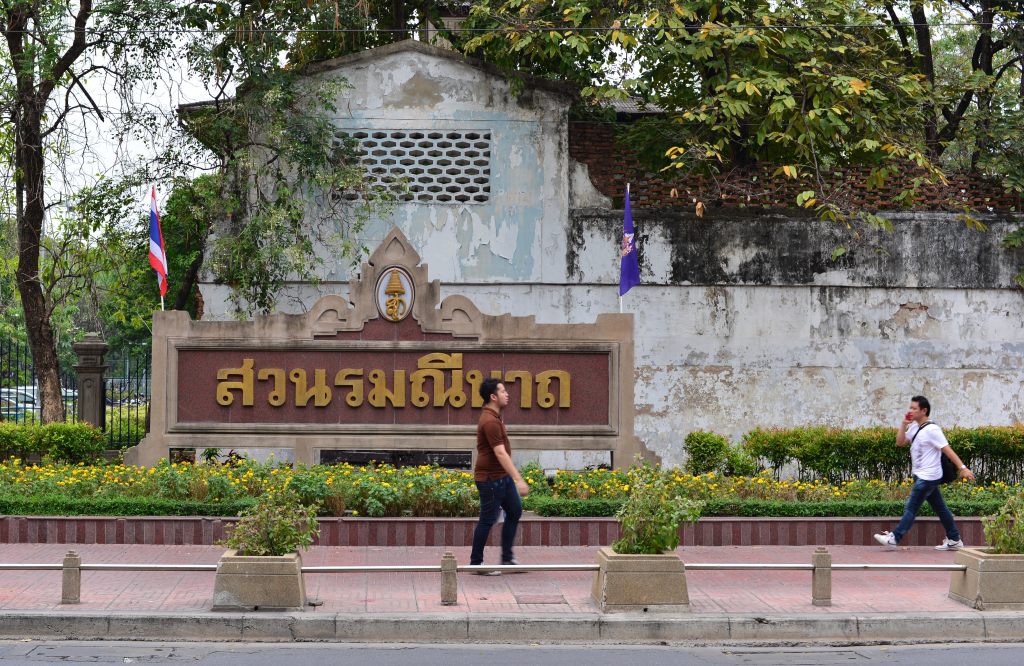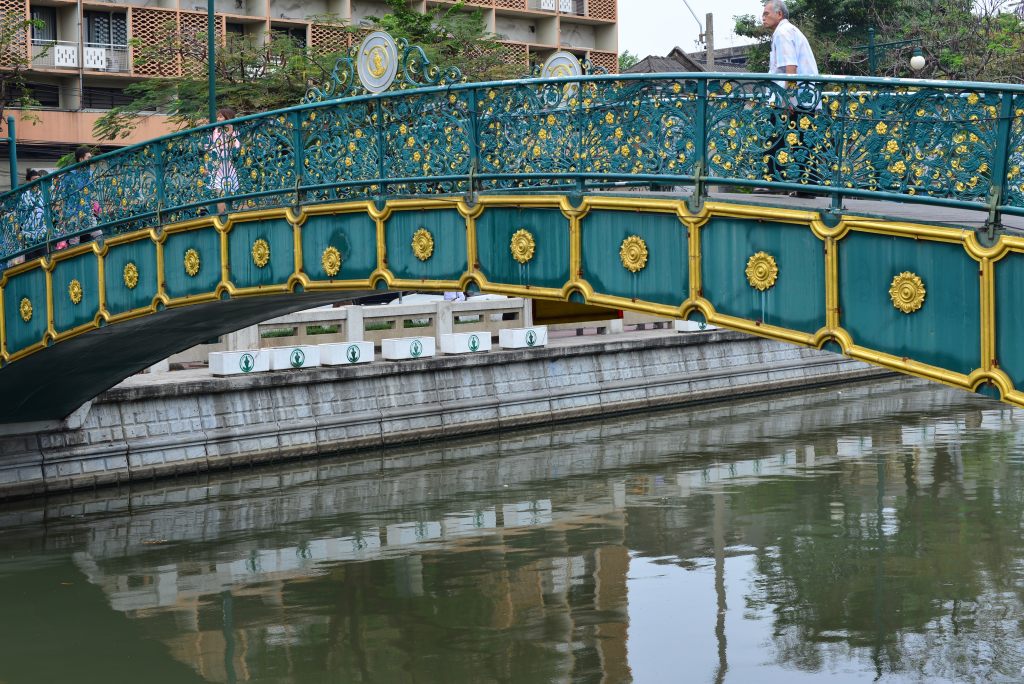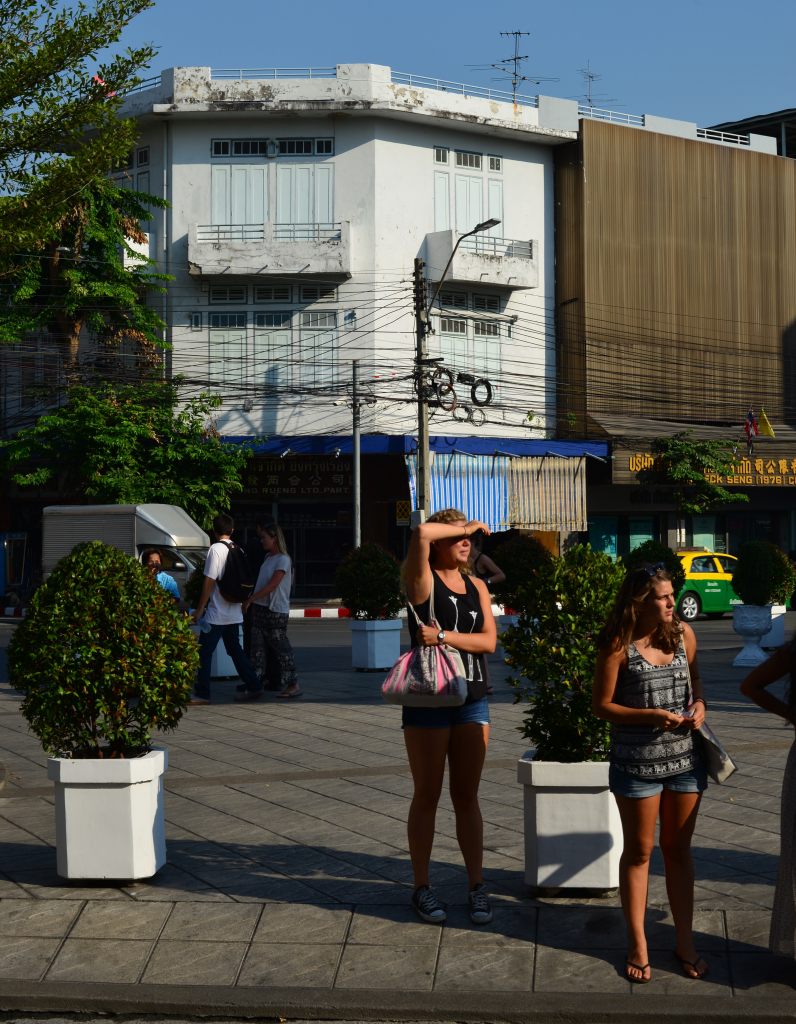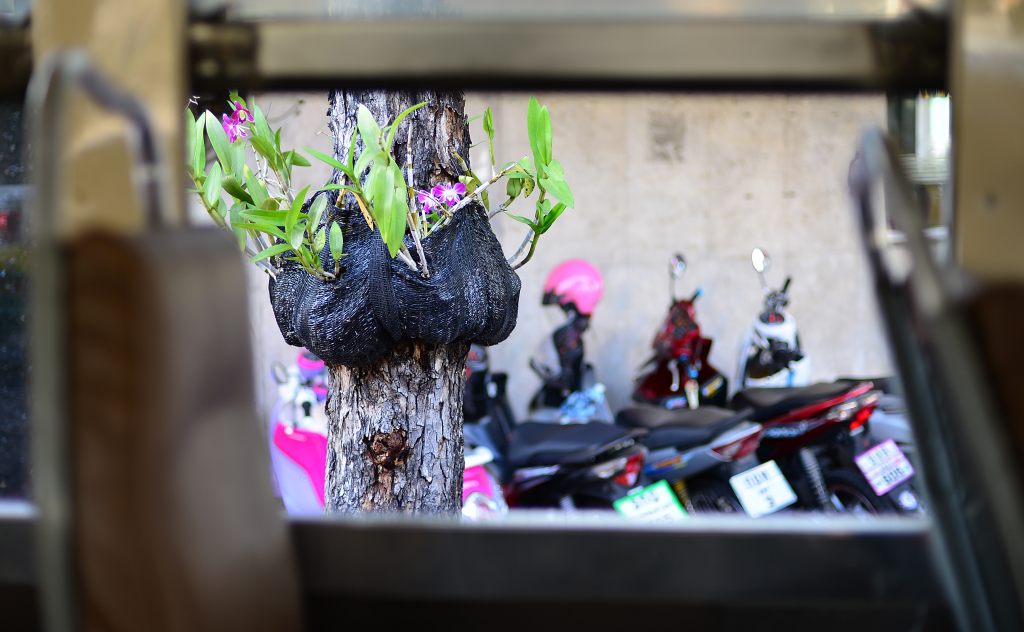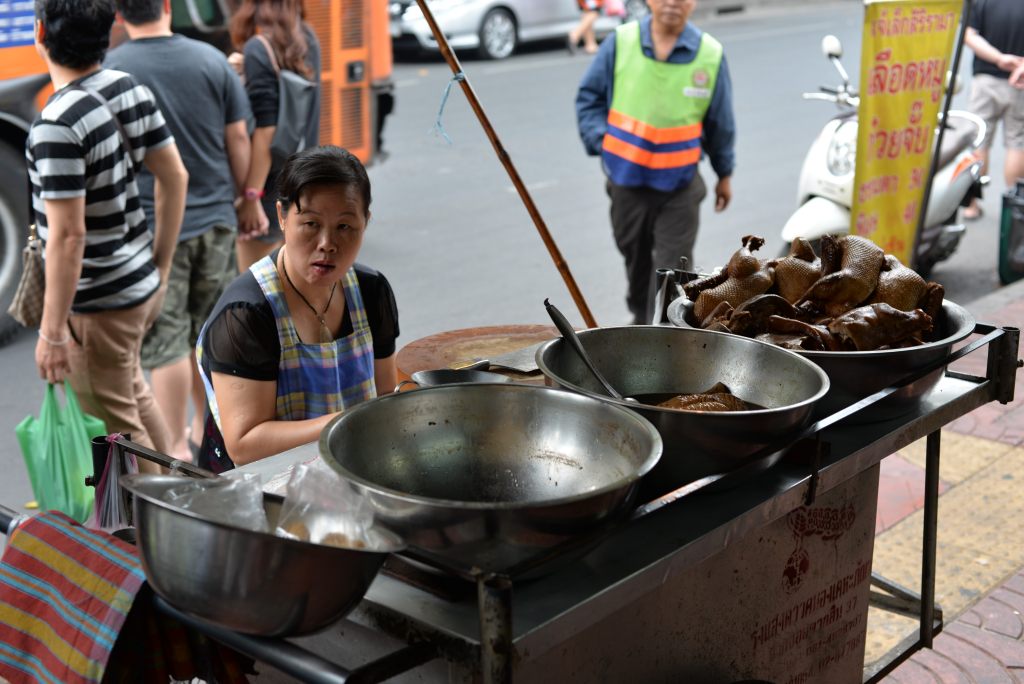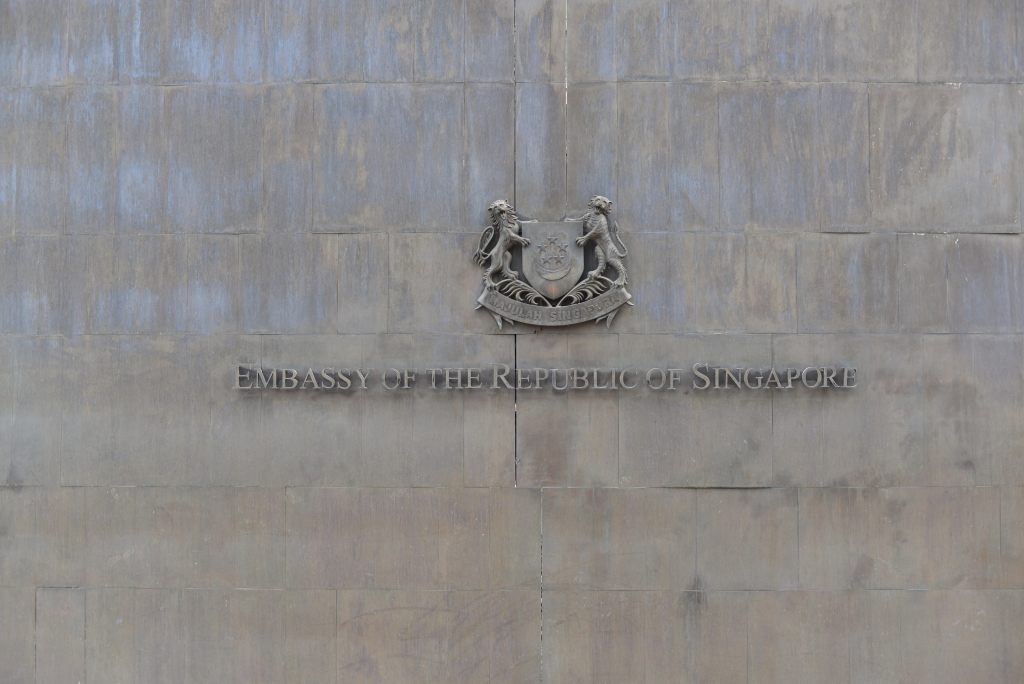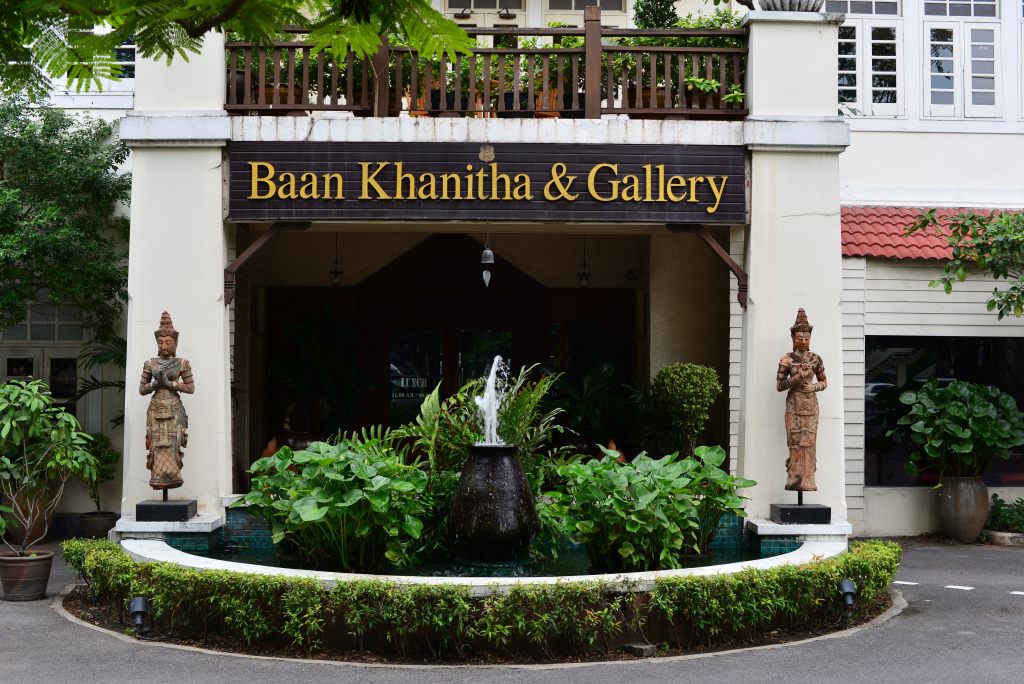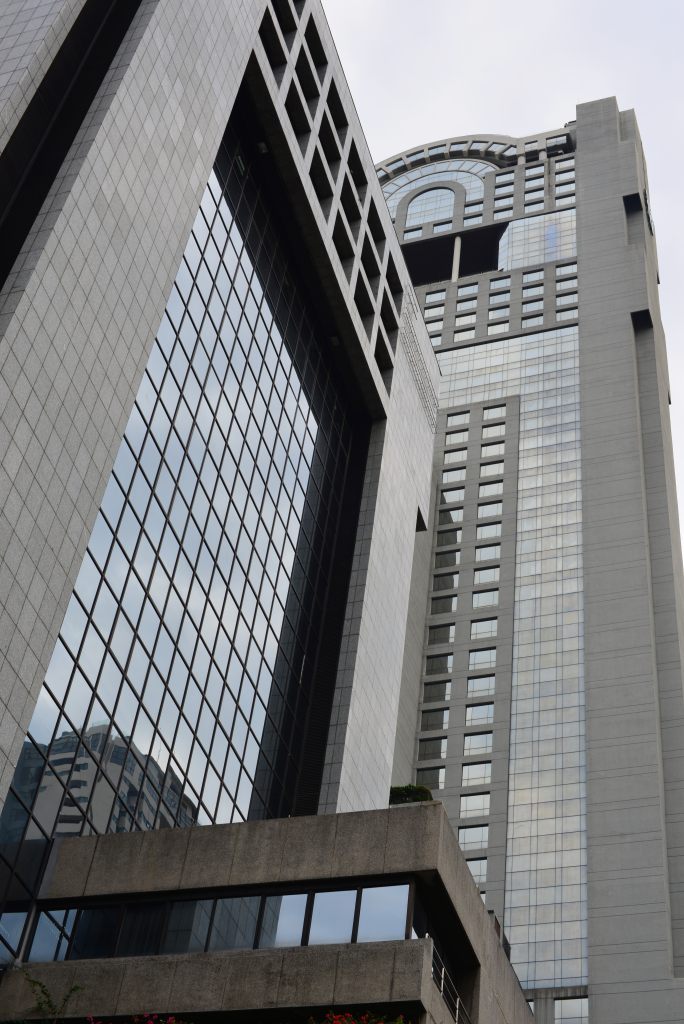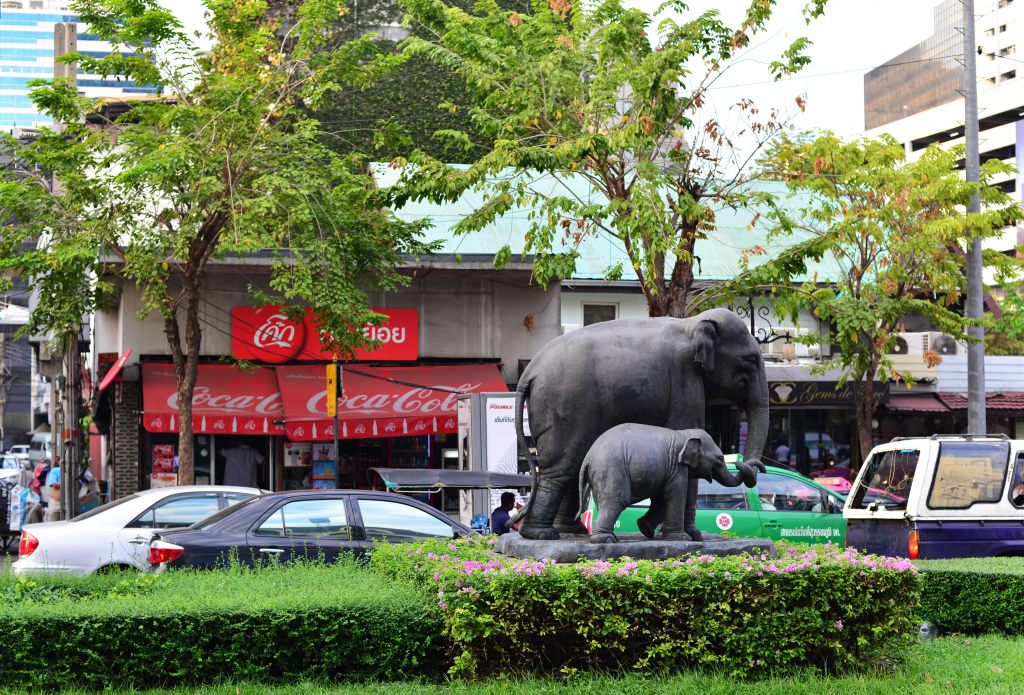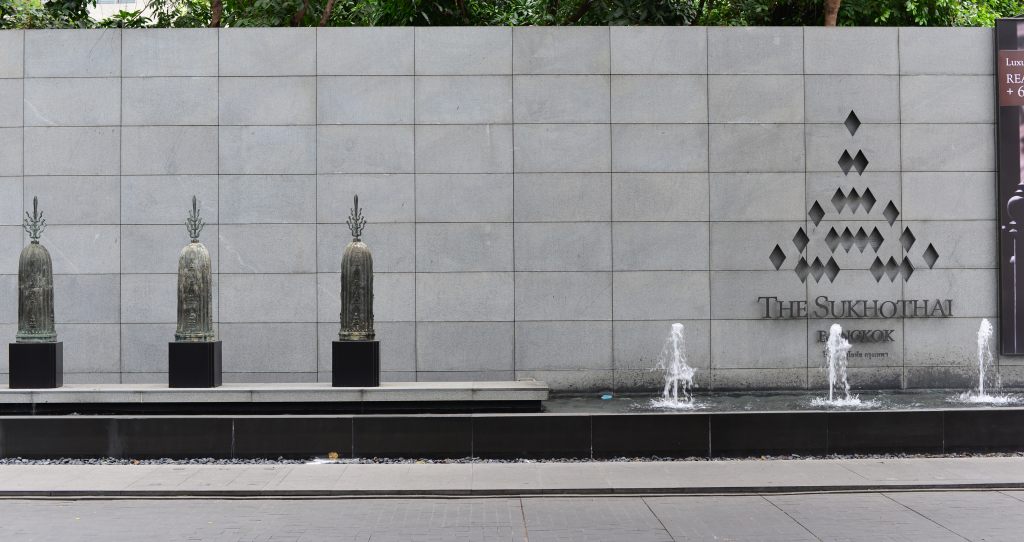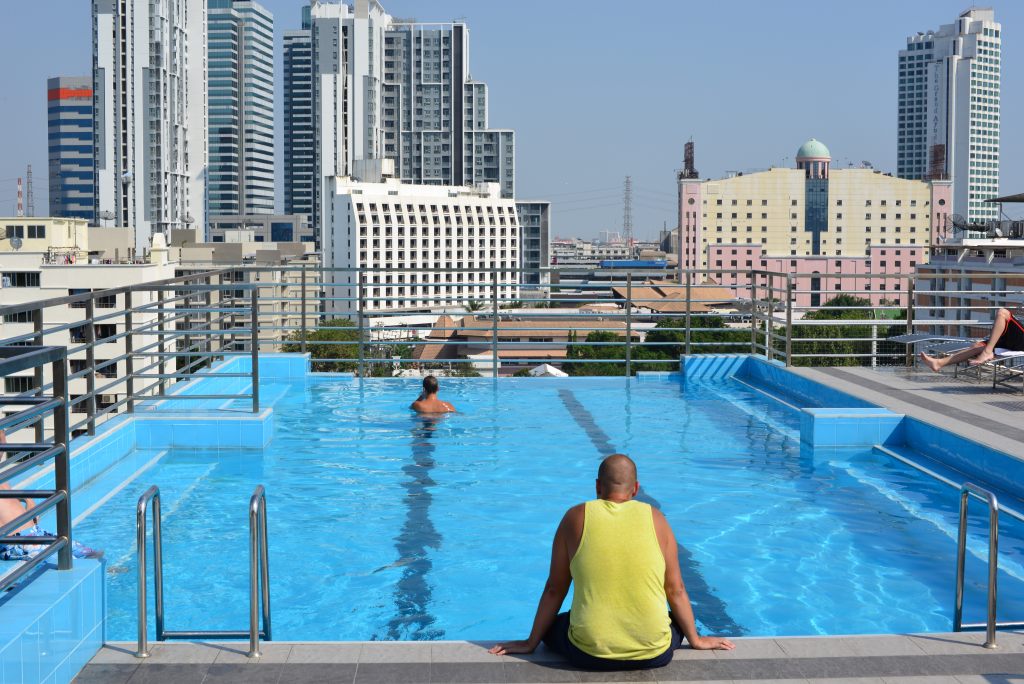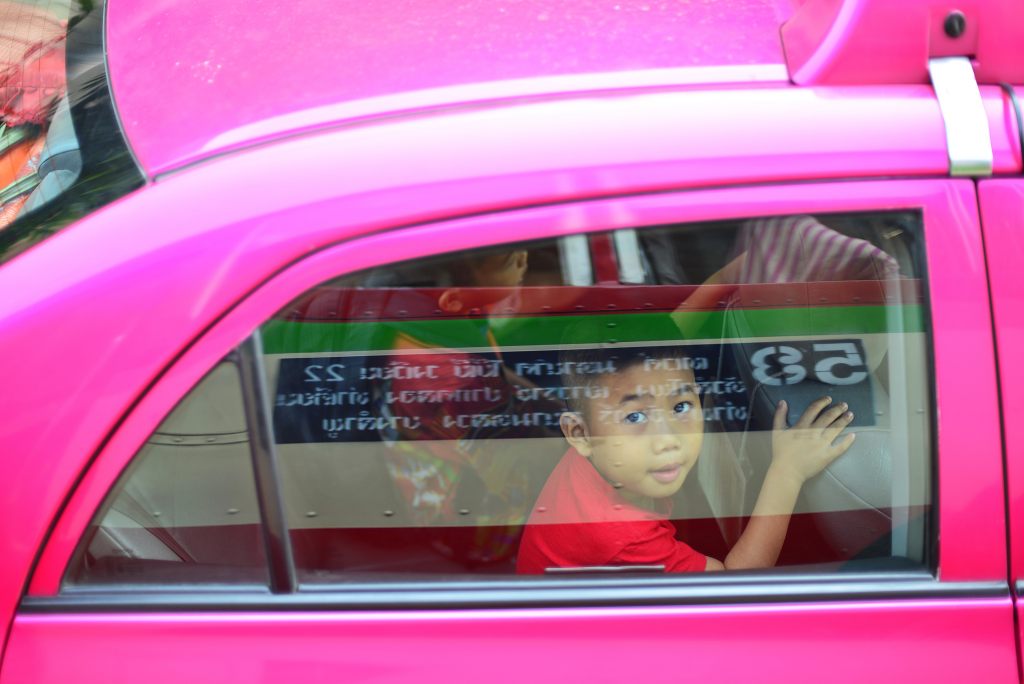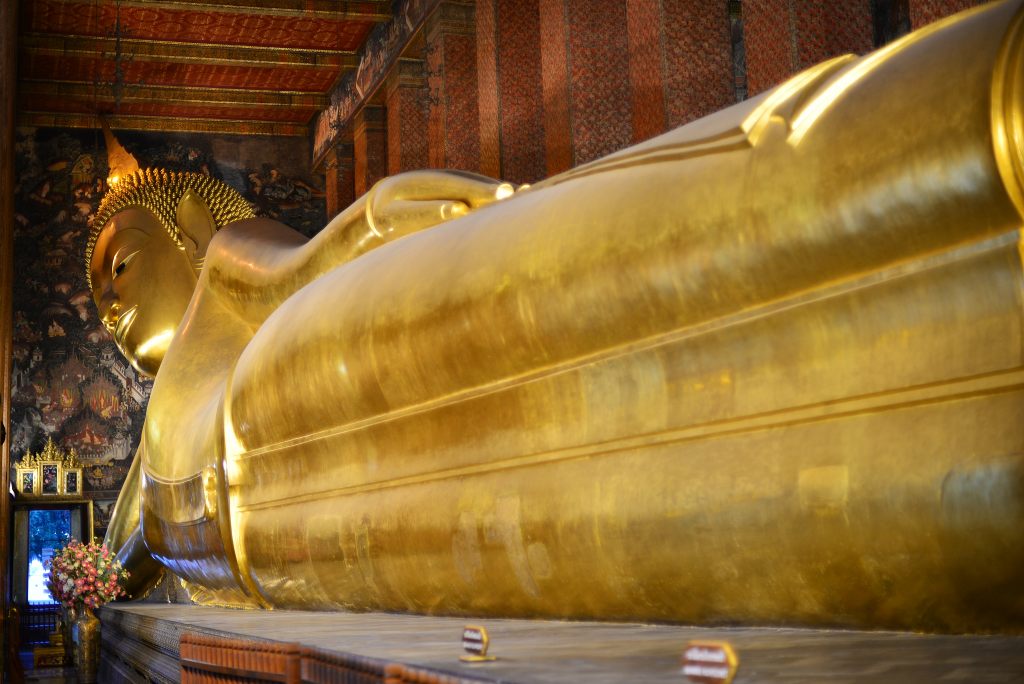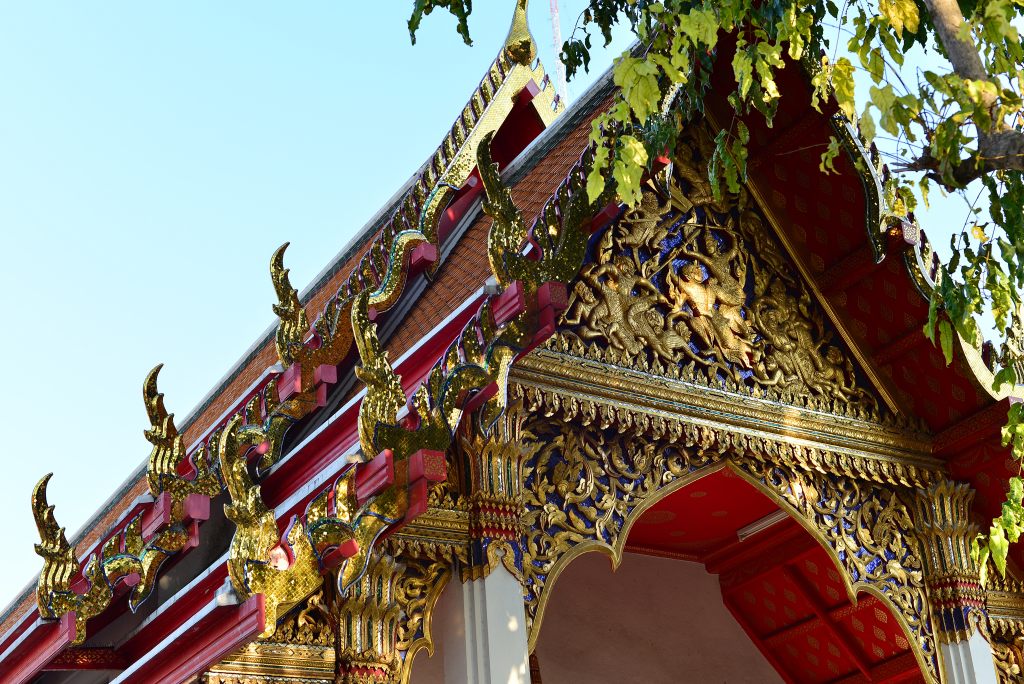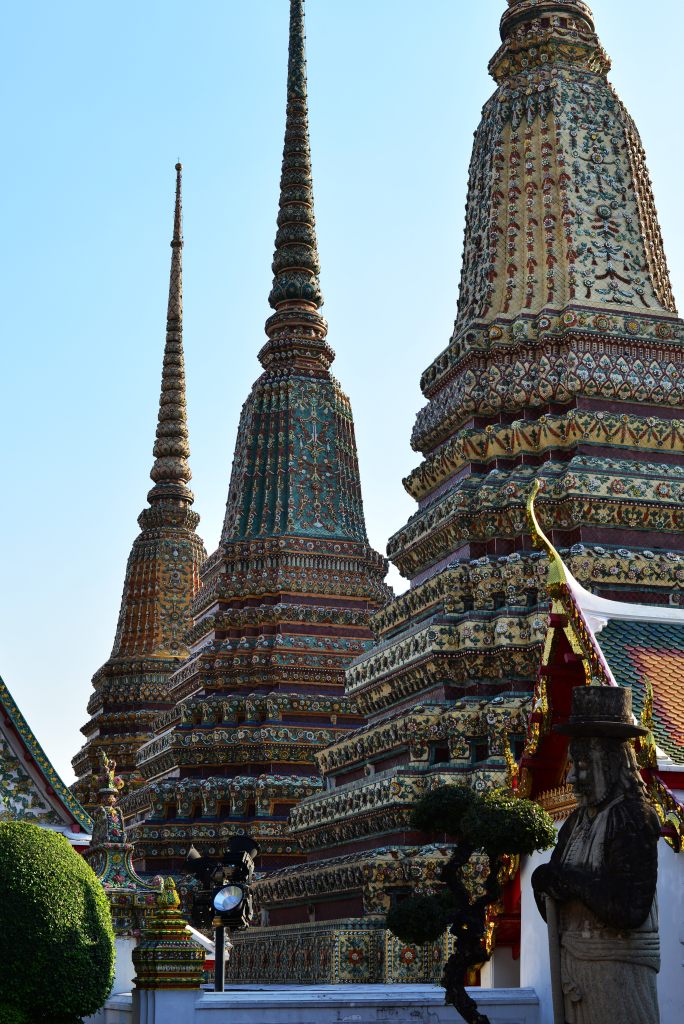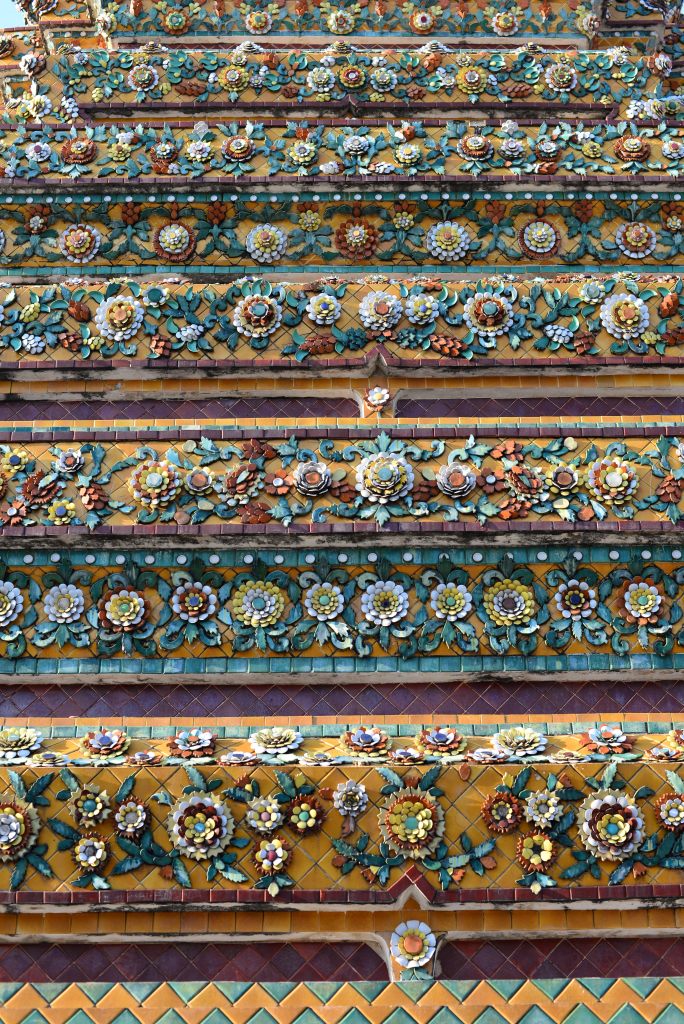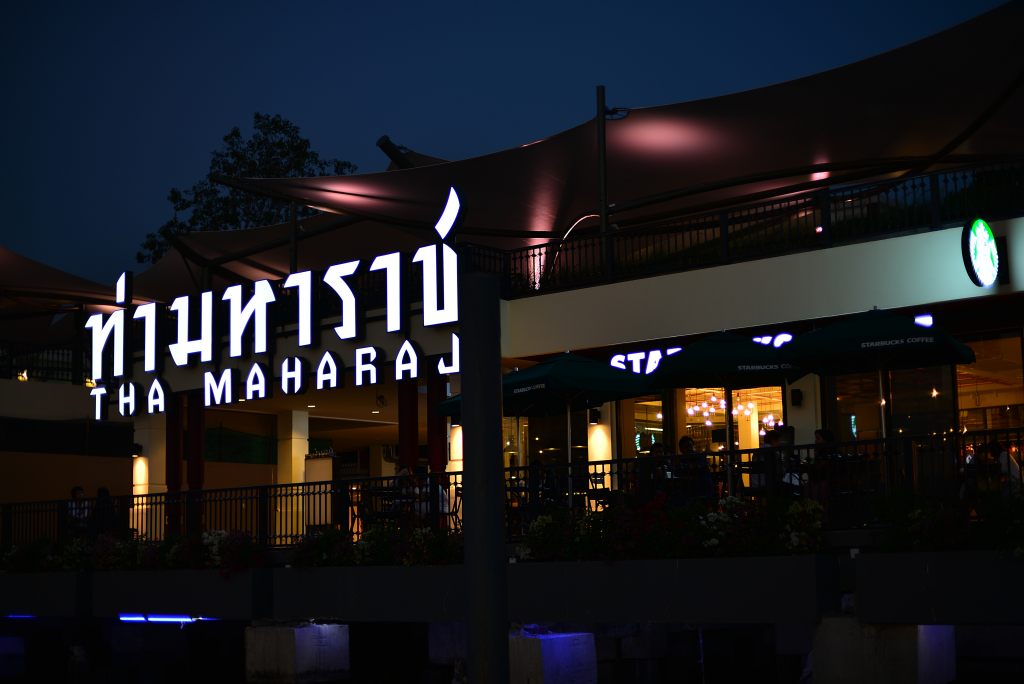January 11th, 2015
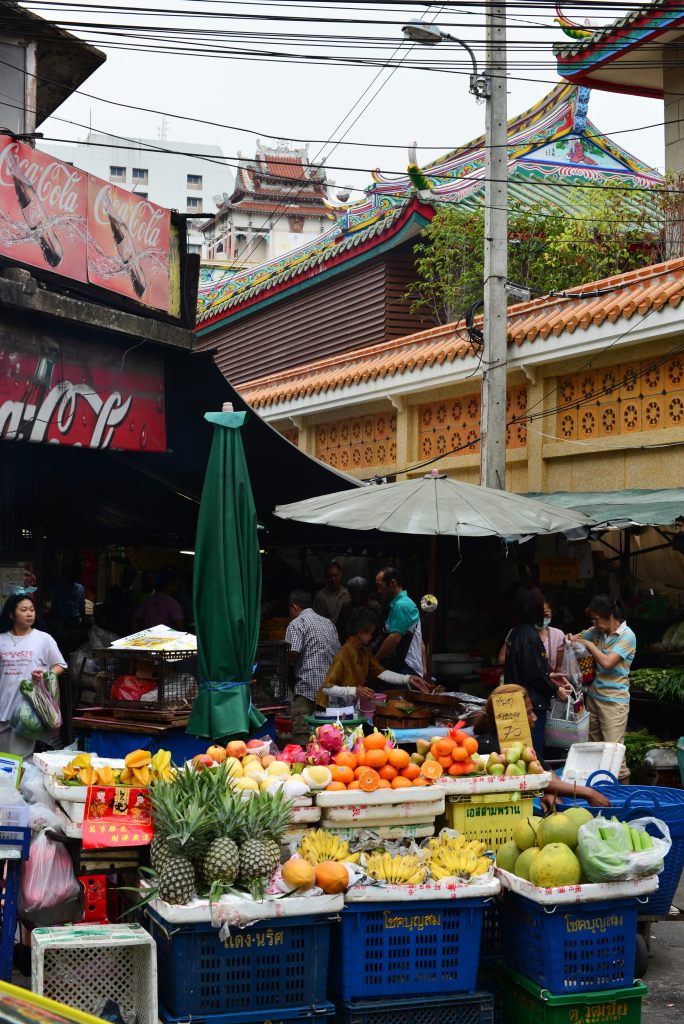
Given that I was arriving so late in the day in Bangkok, I thought I would just stay in the vicinity of the airport to avoid spending a large amount of money on a taxi from the airport. Interestingly enough, airport hotels are less expensive than the ones in town. Of course, there is a wide range of selections available, and I chose one of the cheapest and best, at least according to the online rating services. Despite what the map seems to indicate, the resort is nowhere near the airport, or at least Bangkok spreads out far more than the map would indicate.
The quasi-urban, quasi-industrial periphery around Suvarnabhumi International Airport spreads over a seemingly vast region. And the idea of walking far from the hotel seems somewhat preposterous, given the profuse and confusing gauntlet of highways as well as on- and off- ramps littering the zone. The hotel itself is located in an off-beat industrial/residential compound along the perimeter of a polluted canal. Naming this hotel a resort is a bit of a stretch, but it represents very good value, the rooms spotlessly clean, the implements and services provided working perfectly, including wifi, the building quiet, not that jets taking off overhead would have interrupted my sleep.
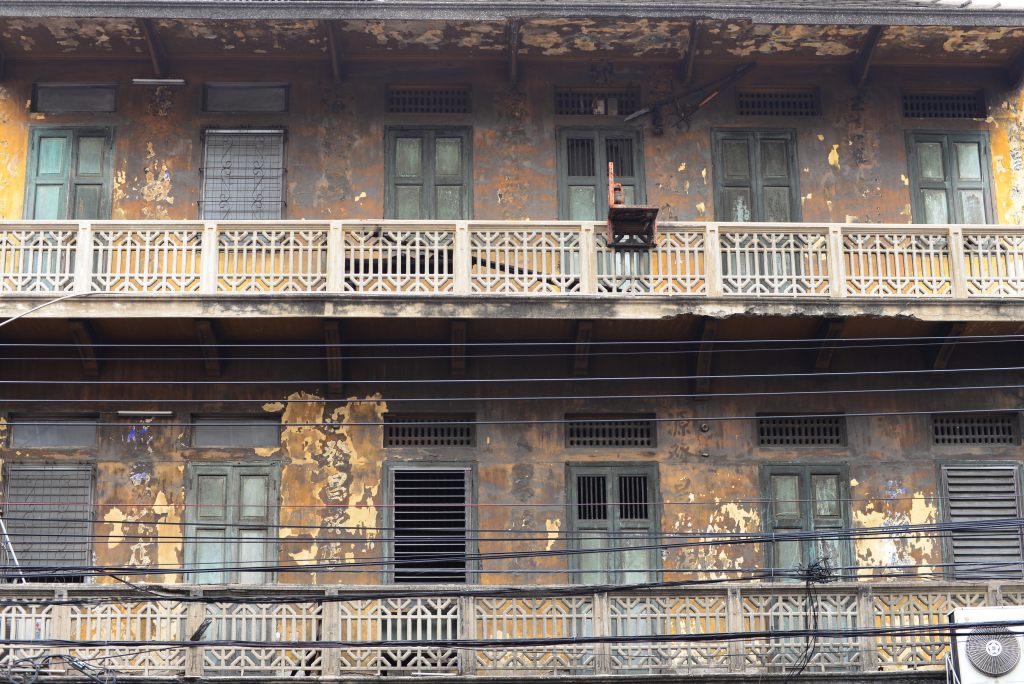
I conveniently miss the cut-off time for the overpriced breakfast, and upon asking the elderly presumptive owner as to what the local eating options may be, he seems somewhat surprised that I would even consider eating the local food. He points me down the alley the hotel is located in, instructing me to walk to the end of the block, then turn left. The man compliments me on my knowledge of Thai, causing me to erupt with laughter. Really? I just used the only three words I know in Thai, although I do remember from years ago that Thai was very simple to learn, which would represent a significant departure from some of the other convoluted languages of the region, not that I have really ever made substantial inroads with Malay/Indonesian.
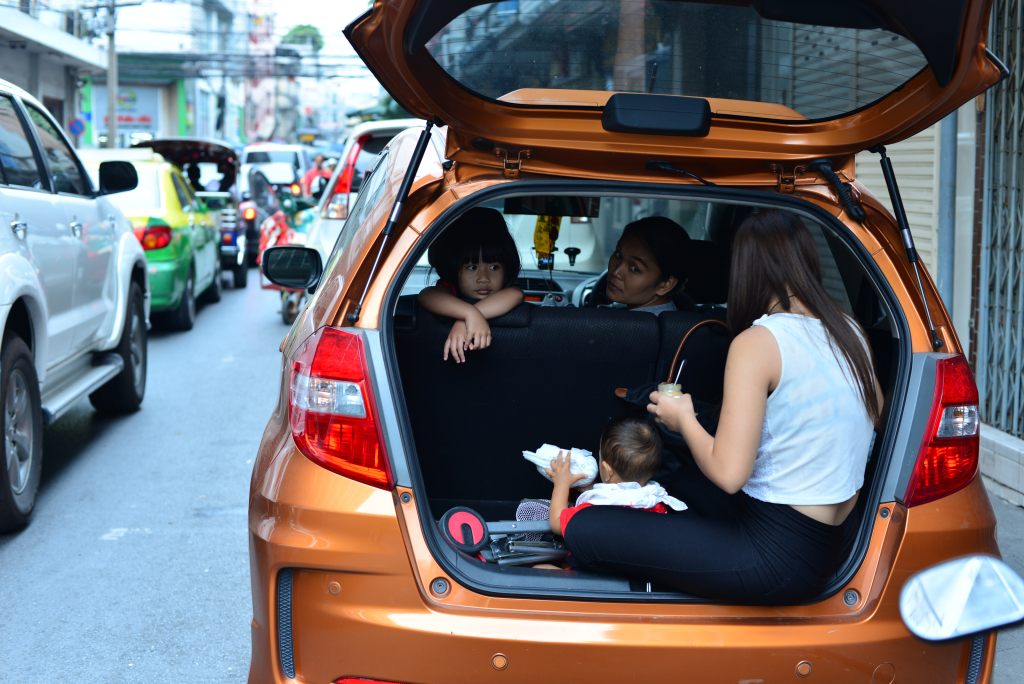
Not far down, a weathered golden temple and some humble roadside eateries represent my introduction to the country, hardly a far cry from what would be seen in any other Buddhist domain on the continent, not that tourists stand much of a chance visiting this kind of establishment. The occasional foreigner could wander in this direction, but people staying at the Airy Resort and like establishment come to spend the night before making a connecting flight, not because they want to explore the romantic possibilities of the neighborhood. Local youth straggle by on bicycles and some on motorbikes, stopping off at the store across the street from the eatery where I enjoy some non-descript pork dishes, the rickety furniture and plastic checkered tablecloths adding some sense of propriety to the place. I order several plates of food, rightfully predicting that getting a solid meal later on may not necessarily that easy, although selecting some of the satay items from the grill later on misfires somewhat.
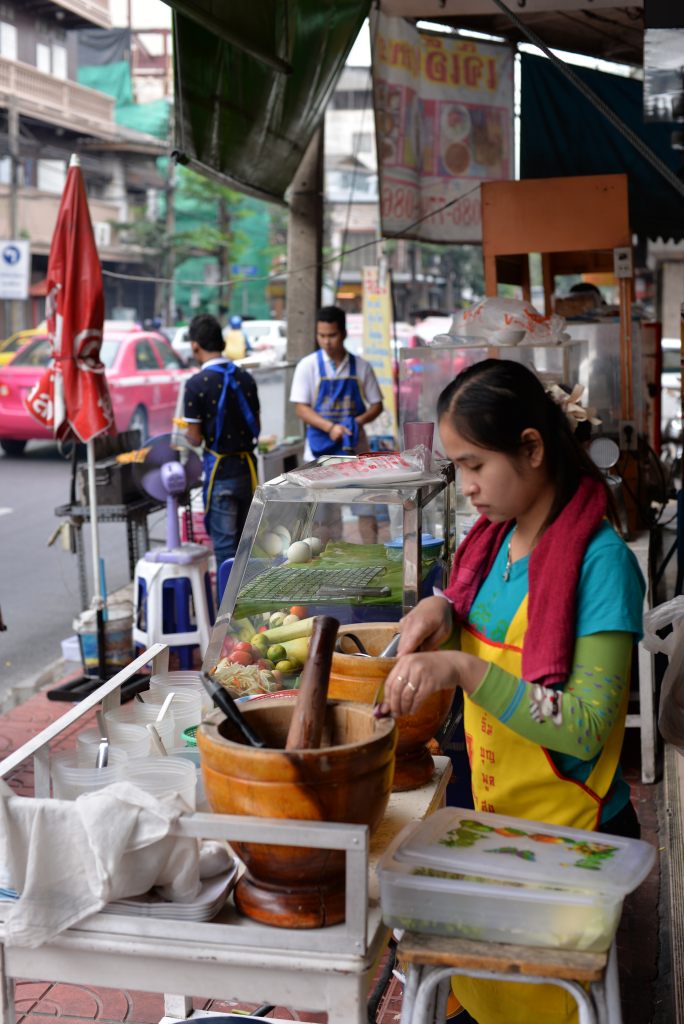
Having packed my bags, checked out of this modest enclave set in the non-descript wasteland on the eastern fringes of town, I embark on a short taxi ride to the metro station, and no, I don’t take up the driver’s offer to drive me into town, given the sleek efficiency of Bangkok’s light rail transit. A ride in the crowded, air-conditioned wagon above the sprawl of the city, clutching onto my backpacks in the overcrowded train, then at Makasan changing over to Petchaburi and heading north. The metro is quiet, efficient, spacious, the infrastructure around it modern, well-organized, sleek, a big step above what is found in other parts of Southeast Asia (although Singapore is probably even better). It all seems so familiar and detached, hardly an experience one would associate with an exotic country like Thailand – but then part of the reason to visit Thailand is to figure out exactly what the country is, and what exactly is exotic about it, if anything. I passed through Bangkok well over 15 years ago and remember next to nothing to the city’s layout.
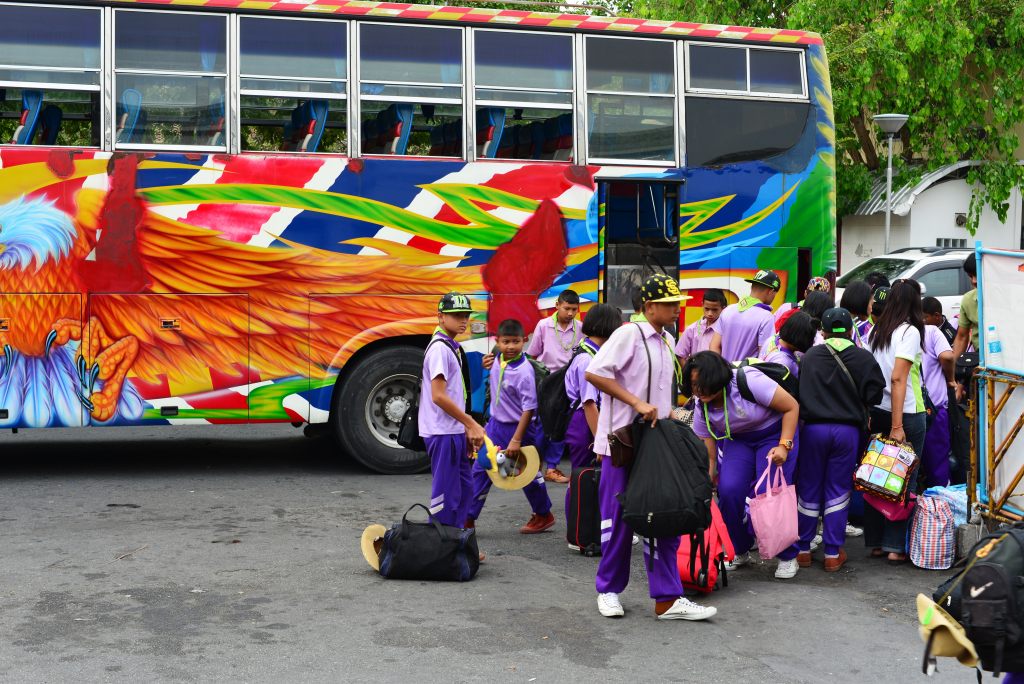
The train windows are blocked by a screen presumably intended to protect against the intense sun, but it also means having little way of discerning the nature of the area, which seems to be general urban sprawl with a lot of interspersed green, as much as may be visible from this elevated location. Gracefully maneuvering with my huge packs is definitely challenging in this crowded train. At Makassan station I have to walk along a circuit of elevated ramps to Petchaburi station and pay another fare, given that it is on a separate system, the Bangkok metro system having incongruously been developed by various independent authorities. The entire system is surprisingly modern and sophisticated, although the ubiquitous advertising looping on the MRT displays is quite annoying. I see people wearing masks in the metro and sneezing, and worry about the chance of getting some serious flu-like infection. Then again, perhaps the people are just paranoid.
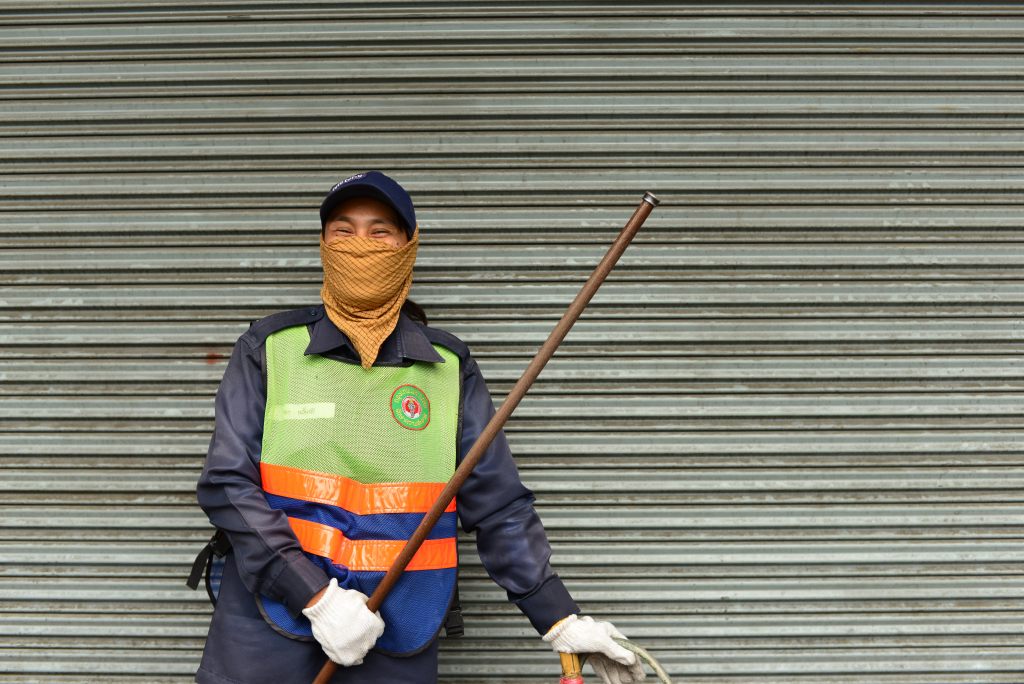
Ascending the long, steep staircase from the metro station, I take in the rushing traffic of the Rachadapisek Boulevard running north-south, and the tall corporate towers and luxury hotels ringing in the viewer, again not what I would expect from Bangkok, although in the end I will be discovering how much the city is really a paean to concrete. Larger commercial businesses line the road as well as large and more moneyed retail establishments. The heavy backpacks elicit an immediate sense of sympathy from the Italian presumably heading in the same direction, assuring me that the street I am looking for is hardly very far away. He works for the Danieli Italian steel fabrication technology company, one of the three leading operations of this nature in the world, although he laments the losing race against the German competitors, what with their superior administrative and engineering talents. My frivolous encouragements only discourage him even further, as he doesn’t see the fundamental drive for quality in his own country’s commercial efforts that gain their Teutonic competitors greater traction with clients.
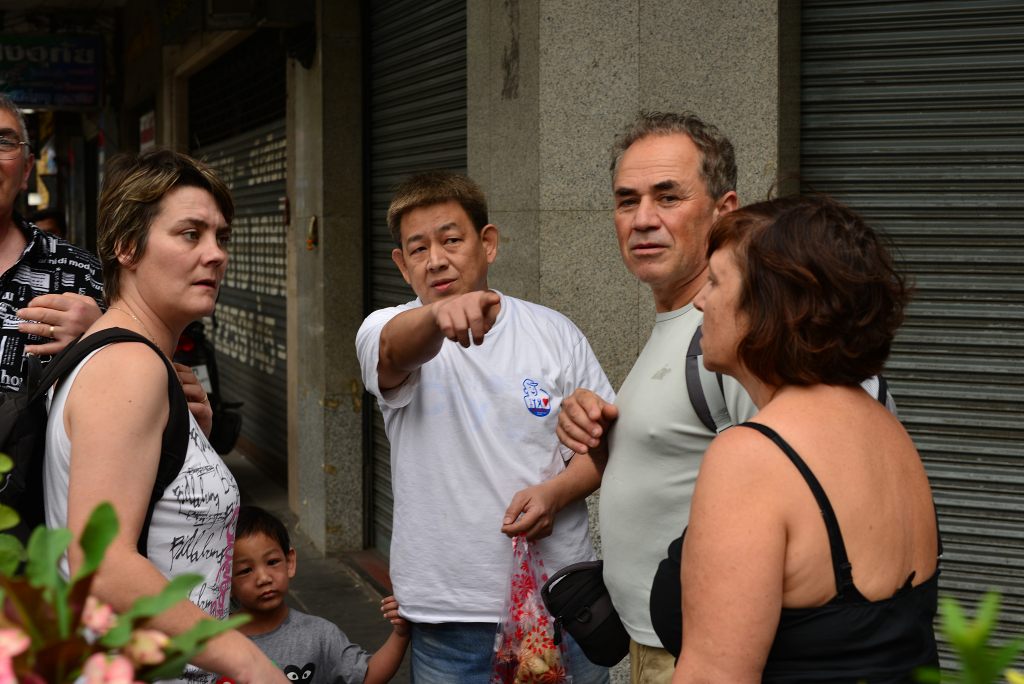
We pass the Max Valu supermarket, open 24/7 and part of the Japanese conglomerate I saw the first outlets of in Ioph, Malaysia, a valuable resource for the itinerant traveller, although it later turns out they don’t even have electrical outlet adapters, the absence of which will cause my very life to suddenly grind to a halt. While the Thai power outlets may accept the American 3-prong plug, domestic power here runs at 220V/50 Hz as opposed to 120 V/60 Hz in the U.S. and Canada. And the ubiquitous absence of ground here is always a cause for concern. An outlet of Au Bon Pain sits next to the McDonalds, a chain establishment that would represent an adequate fallback position in the absence of suitable alternatives, especially if the weather gets too blisteringly hot, which it definitely is not at the moment.
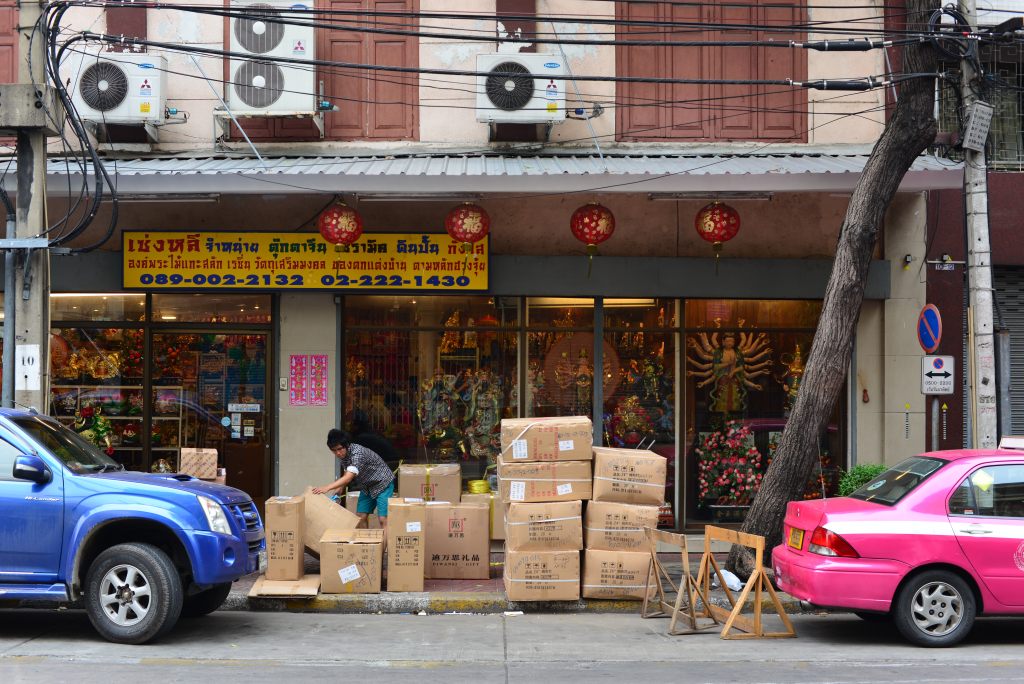
The McDonalds needs no introduction, and soon we are on Rachadapisek Road 17, where my destination, the Bangkok 68 hotel is located. We pass by the Copacabana, a massage club of gigantic proportions, a paean to the country’s reputed debauchery, Thailand’s Buddhism going hand-in-hand with the tolerance of excesses. A narrow, winding road with moderate traffic, a few tiny locales and largely residential towers meanders before me, the Bangkok 68 Hotel’s tower lying immediately behind the Siamaze hotel. The location of the hotel is definitely in an off-beat area, although from what I see later on in the day, the location may not be so bad after all.
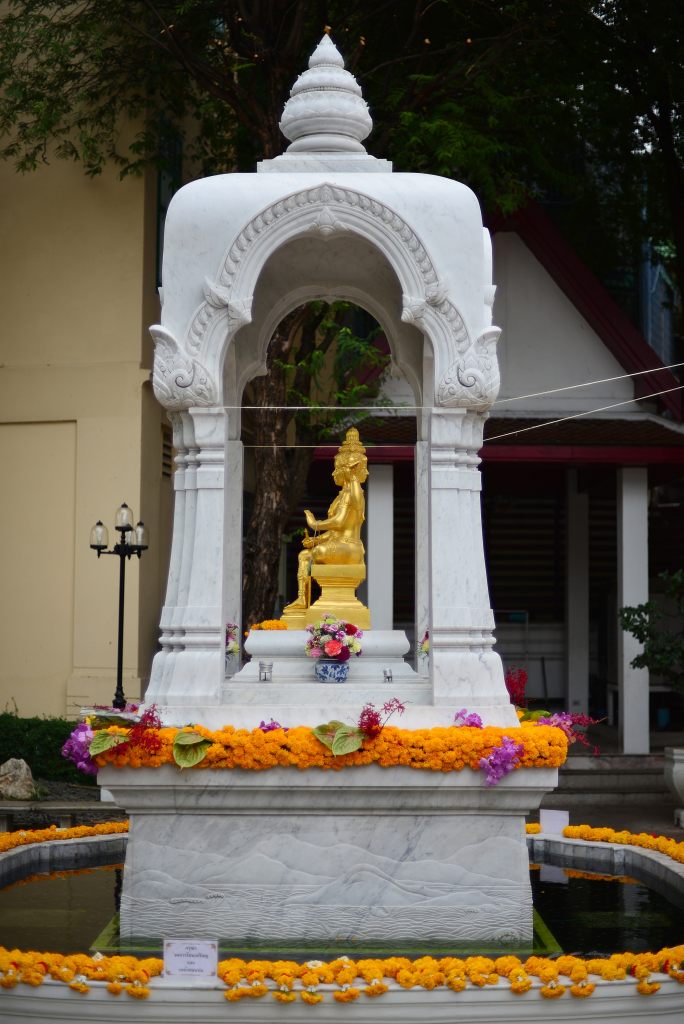
Some confusion arises inside the somewhat narrow and institutional-looking lobby as to whether I have to pay for the room in advance. Such is the disadvantage of having booked using Booking.com, although it is actually not necessary to pay in advance with some of the online booking sites, as some provide the option to pay later. I spent enough time researching the alternatives, and simply don’t want to spend even more time trolling through online resources to find a better option. In any case, I plan on returning to the city on several occasions, so that I can experiment with finding hotels in different areas of the city. Institutional or not, the hotel is very proper, clean, the elevators function properly and are quick, the corridors somewhat reminiscent of a prison, but then the hotel plays with an industrial motif, the rooms outfitted in a polished concrete that looks somewhat drab and yet chic at the same time, although cleanliness and functionality are the rule of the day.
The bed is ample in size, the air conditioning functional but not ferocious – although it unfortunately cannot be modulated – the wifi impeccable, with a somewhat stark but comfortable chair and table available for my writing pleasures. The window faces some other tower next to the building, not that I would expect tropical gardens full of cawing hornbills and chattering monkeys in this city. Yet later on, from the small and yet luxurious rooftop deck I notice that the Rachadapisek area is in fact very verdant, especially with respect to the city centre. And above all, the room is very, very inexpensive.
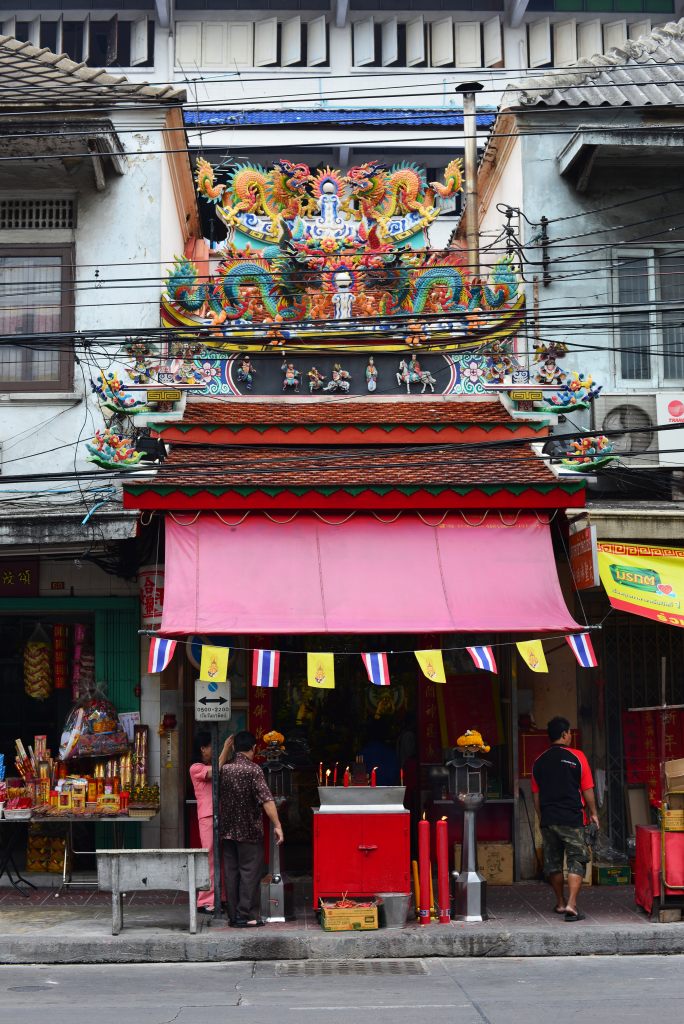
The young man at the reception discourages me from expending too much effort exploring the area, as there is apparently nothing to see. The night market near the Hwai Kwang station further to the south he does recommend, although my subsequent trip through the side streets becomes somewhat derailed, what with the fact that the alleys that are supposed to rejoin Rachadapisek Boulevard in fact dead end into residential developments. He was right – there is little to see in the area, other than generic upscale residential towers hemmed in at close quarters, a jumble of parked cars littering the grounds hugging the buildings, the ostensibly wealthier occupying sprawling and leafy low-profile compounds.
There are also vestiges of small eating establishments, most of them offering espresso-based coffees, which seems like a bit of a shock to me, considering how much time I spend hunting for good coffee elsewhere in Southeast Asian countries. Even though I am somewhat at loss as to finding a way of locating the Hwai Kwang station metro station, at least I feel I have arrived at some sense of perspective to this presumably genteel and yet overdeveloped neighborhood, which later turns out to be a decent option compared to the centre or Sukhumvit road, not that after one day in Bangkok I can profess to much of a sense of the city.
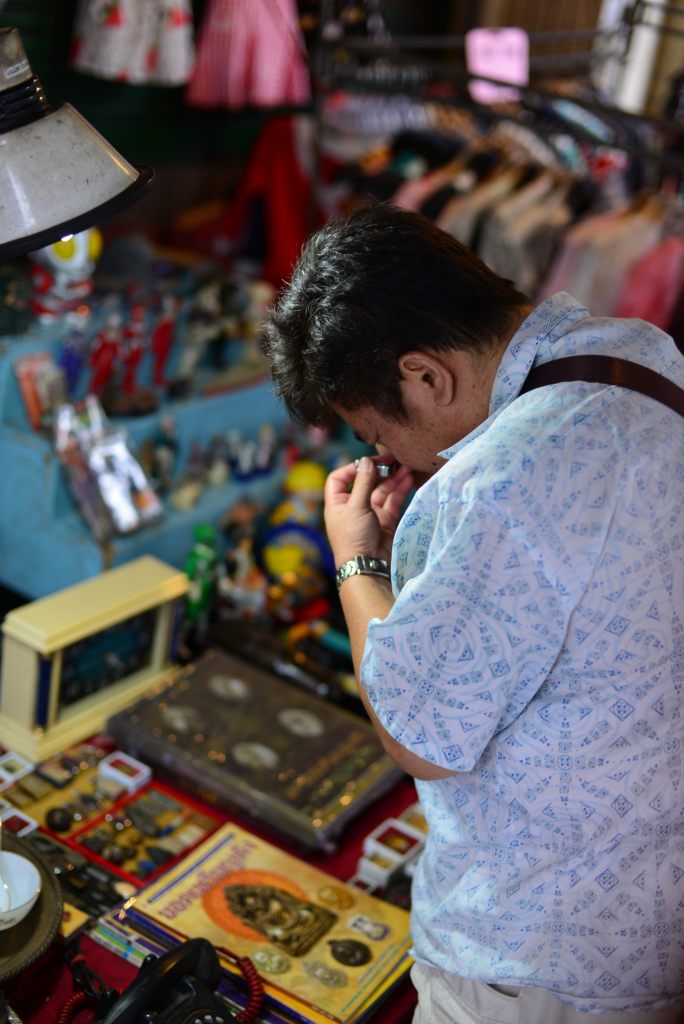
Weaving through the complicated side streets of this neighborhood, I finally rejoin a main artery running west towards Rachadapisek. Almost surprisingly, many of the principal roads in the inner city have dedicated bike paths separated from the main road by concrete meridians, representing a substantial sacrifice of urban space to cyclists. I see innumerable small stalls lining the roadside, vendors lethargically making attempts at preparation for the evening market. The disarray of pots and pans, condiments and chopped vegetables hardly looks that inviting, never mind the copious amounts of dubious-looking meats, largely innards.
More importantly, just around the corner, on the presumptive Rachadapisek road the Hwai Kwang metro station, and the promise of a trip into town. I toy with the idea of making a late visit to the royal palace, grossly miscalculating the amount of time it would take to reach the palace, given that the rapid transit only grazes the periphery of central Bangkok. As much as I am not fundamentally motivated to see the city, I drive myself simply given that I should have some idea as to the nature of one of Southeast Asia’s biggest cities.
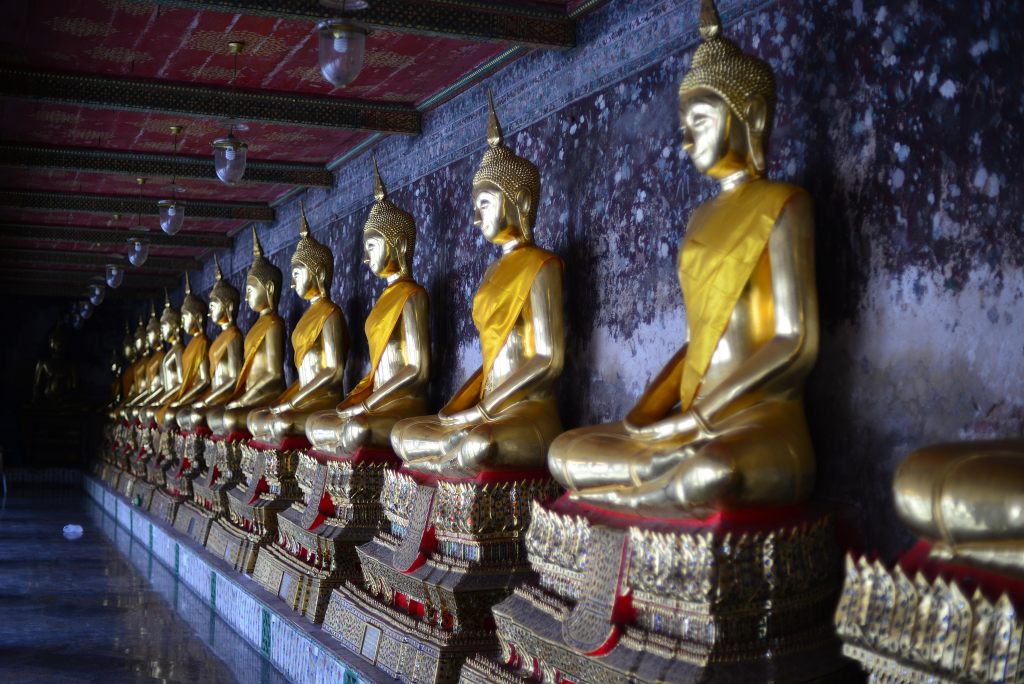
Back into the air-conditioned tomb, each sleek Skytrain only minutes apart from the next, further north in the city there still being some chance of getting a seat, which someone in my age group normally appreciates. By the time we reach Sukhumvit Road, any chance of sitting is dashed altogether. Station upon station pass in the blaze of fluorescent light, impeccably dressed young locals glued to the glare of their cell phones, and the relentless advertising looping on the overhead monitors. Since this train runs all the way to the Hua Lamphong train station, which seems like the nearest train station in the inner city area, I may as well as stay seated until the bitter end, glued to the pages of my travel guide but constantly distracted by the comings and goings of the morass of passengers, heavily amended with a wide range of tourists.
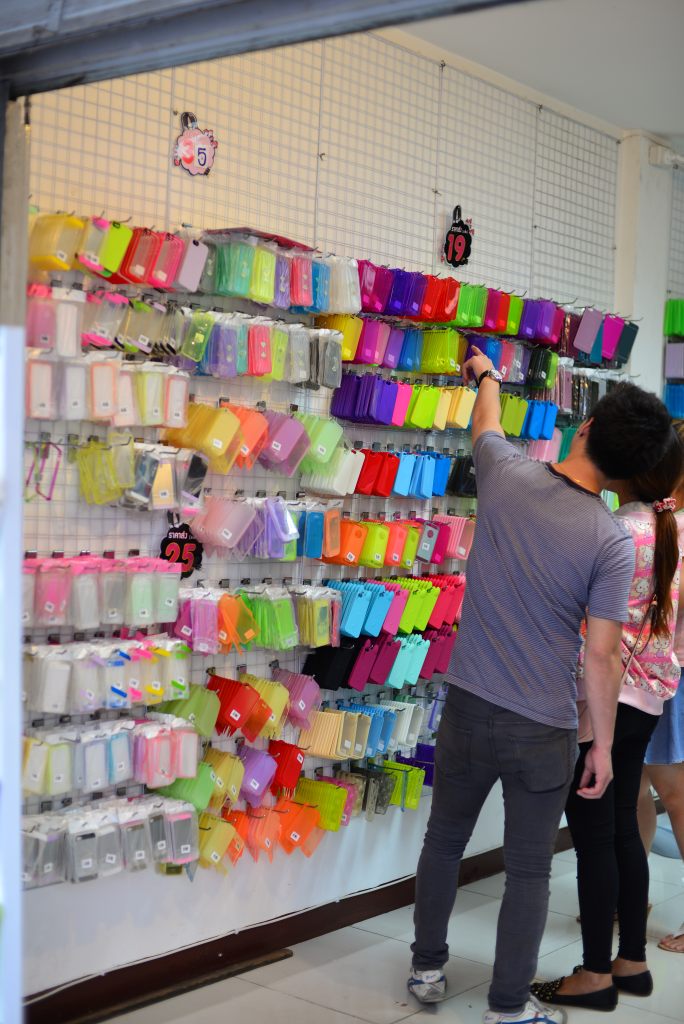
At Hua Lamphong, I am greeted by a bedraggled mix of modest locals camped out on the terrace, waiting for trains to some yonder destination deep in the countryside, the occasional backpacker, station attendants, baggage carriers, and taxi drivers aggressively promoting their services to the vaguest hint of farang. The area around the train station is a blend of non-descript run-down urban sprawl with odd bits of Baroque colour thrown in, chaotic traffic funneling around the incongruously placed neo-Classical train station. Ornate Taoist temples herald the vicinity of Chinatown, with its concentration of commercial activity, trucks being loaded and unloaded on the densely-trafficked streets, the threadbare sidewalks barely passable with the volume of locals and tourists, the latter testing the patience of even the calmest Thai, stopping constantly to peer at the exotic wares heaped in wicker baskets, a relentless stream of merchandise only vaguely identifiable to the European visitors.
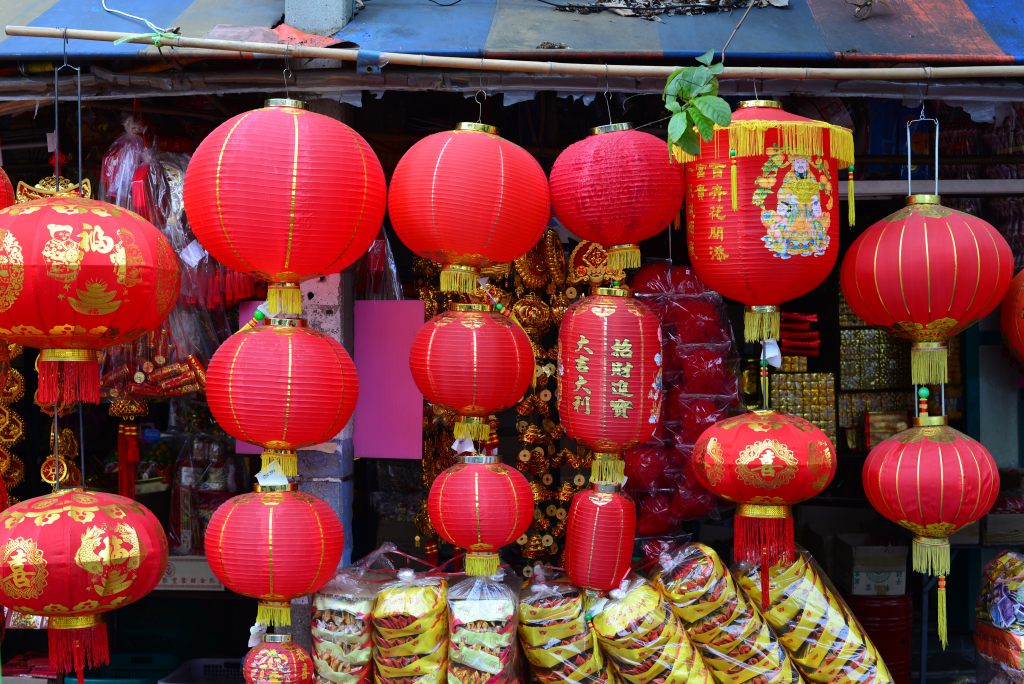
The old city’s redeeming features are the innumerable soi or back alleys populated with businesses and small local eateries that seem to render the place much more vibrant. The volcanic activity and colour of this historic central neighborhood presents a lively counterpoint to the otherwise drab uniformity of modern Bangkok, one of the few vestiges of the messy city that once was. The brilliantly gilt ornate carvings shimmer on the Buddhist temples set against the rich red pomp of the Taoist temples, a regal counterpoint in turn to the profane chaos on the street, limited only by the physical width of the sidewalks and streets intended to contain the vast flow of vehicles and humans.
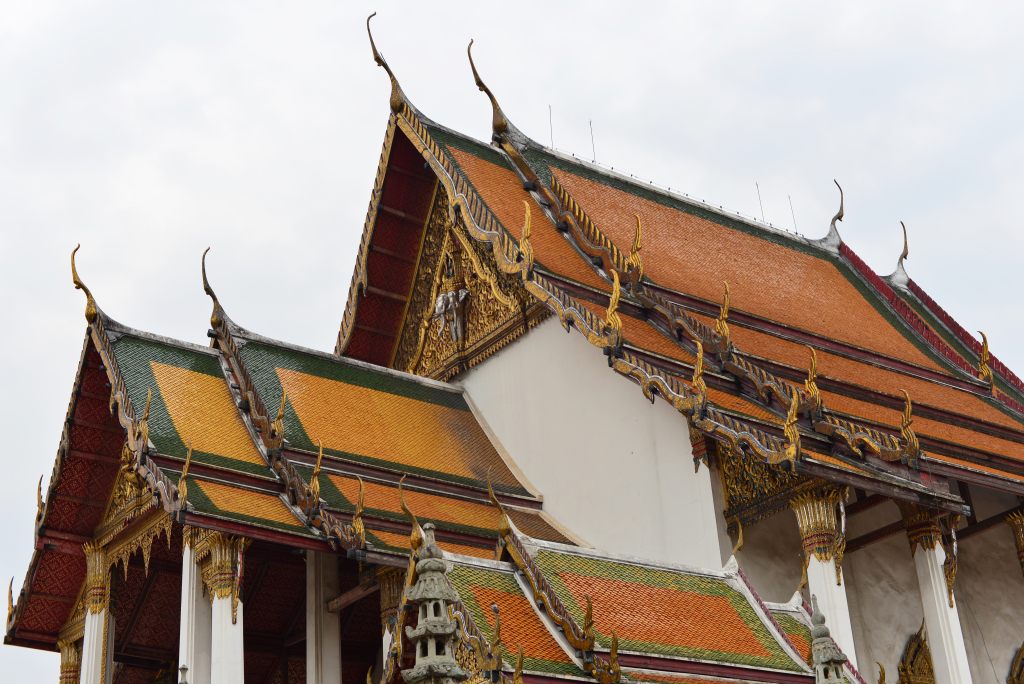
I would really love to just stop off somewhere in town and have a coffee and collect my thoughts. Something tells me that Bangkok may have some great coffee shops, but they are definitely not visible in this neighborhood.
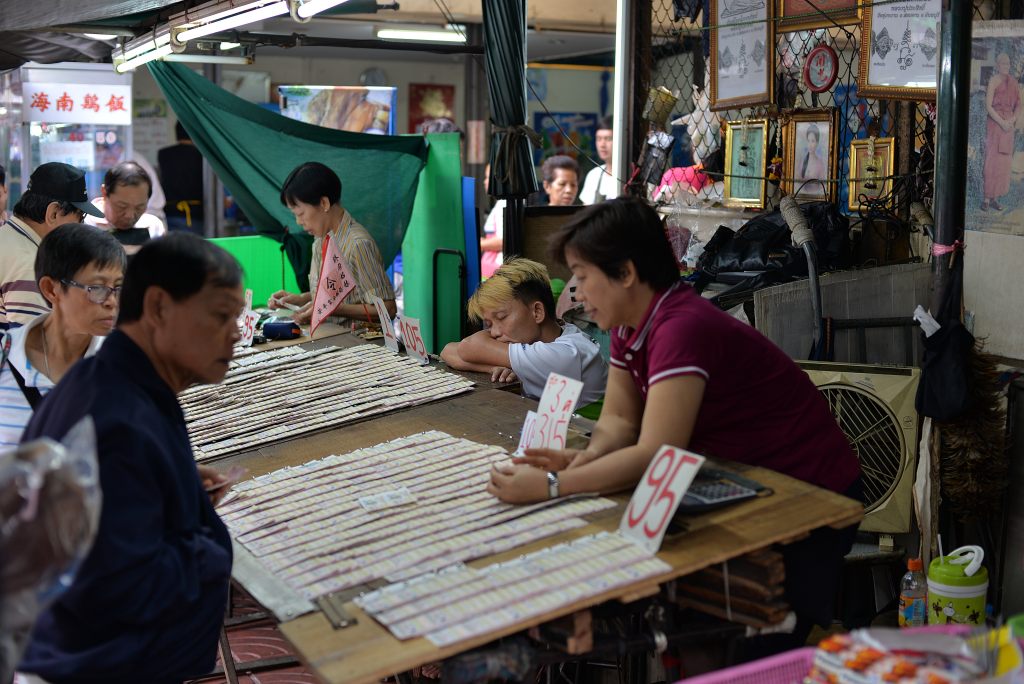
I am actually quite surprised as to how respectful Thai drivers are. I cringe at the memory of the aggressive drivers in Kuala Lumpur last year in Malaysia. Then again it is Sunday, and it could also be that traffic is well-managed enough for people to be able to rely on the rule of the law, rather than take matters in their own hand. I struggle to place the character of the Thai, somewhere impassive and polite, inoffensive, averse to losing face, with a predilection for slight bouts of eccentricity, at least what I see in Bangkok, an errant charisma with somewhat mysterious fascinations.
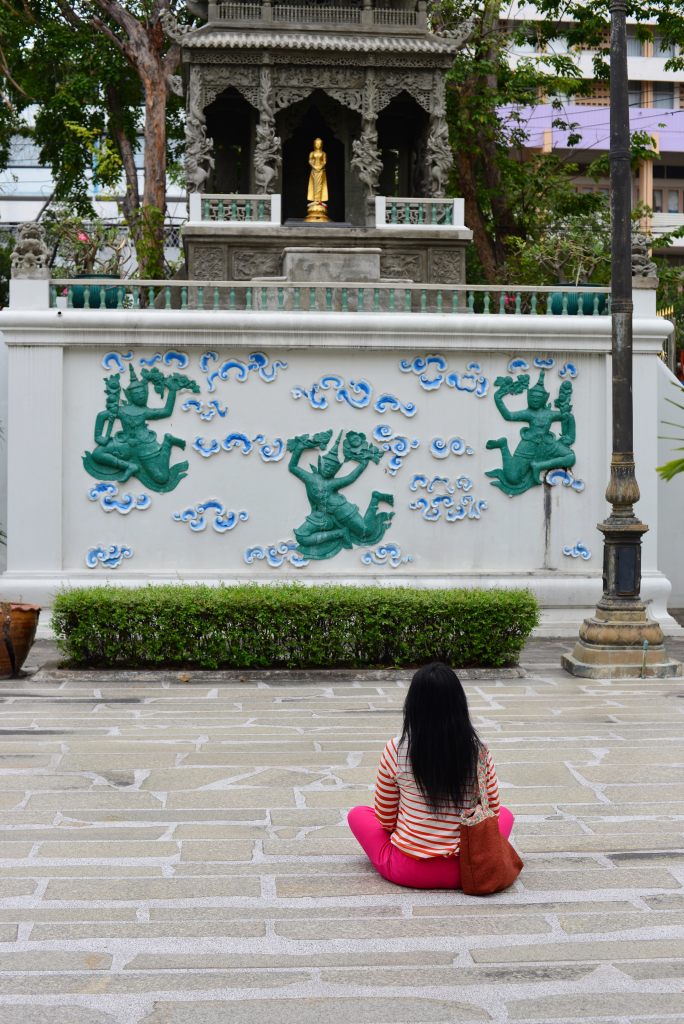
Frustration mounts with my newly acquired camera, its christening being less seamless than I had hoped. It is a bit frustrating trying to orchestrate focal areas of the camera, as it is even more complicated than what I was used to with the simpler Nikon I used to have. I can’t stage zoom-like effects with the 50 mm prime lens, so that I have to compose photos without being able to play with depth.
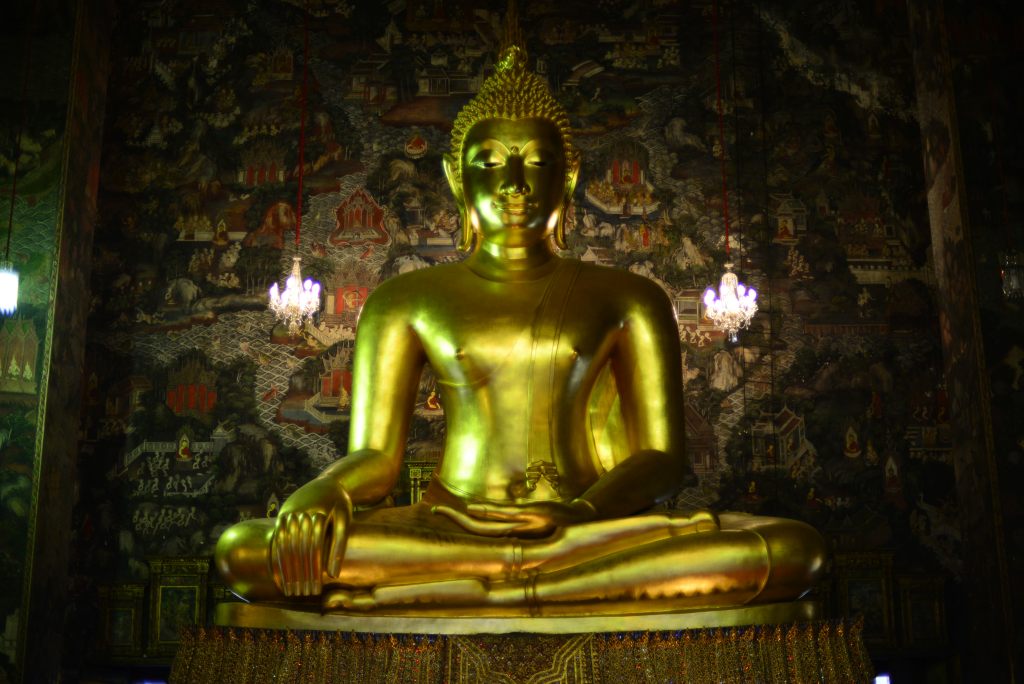
It’s very hazy today, not sure to what extent it is a result of pollution. From the lack of overpowering fumes emanating from vehicles it is apparent that there must be reasonably good emission controls in place.
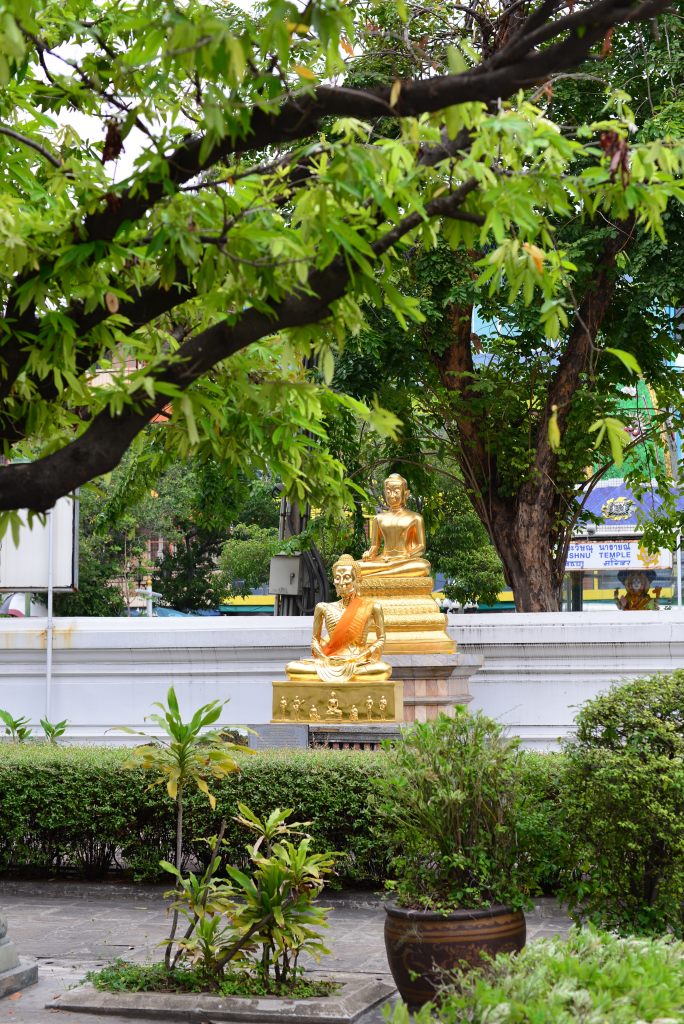
Expelled from the far side of Chinatown, the journey becomes less laborious, given the diminished crowds but also more drab urban setting, emanating little of a sense of urban centricity other than the constellation of Buddhist temples I cross paths with, including Wat Suthat. A haven of peace in this desultory, steaming city, the broad terraces set against the immaculate bronze tiled layered roofs with soaring golden finials. Interior passages lined with identical gilt seated Buddhas recede into the horizon, while the sheer surfaces of the building exteriors are lined with intricately patterned golden doors, the flanking collonades culminating with peaked crests riding overtop, the dazzling patterning drawing the eye deeper and deeper into its visual trance.
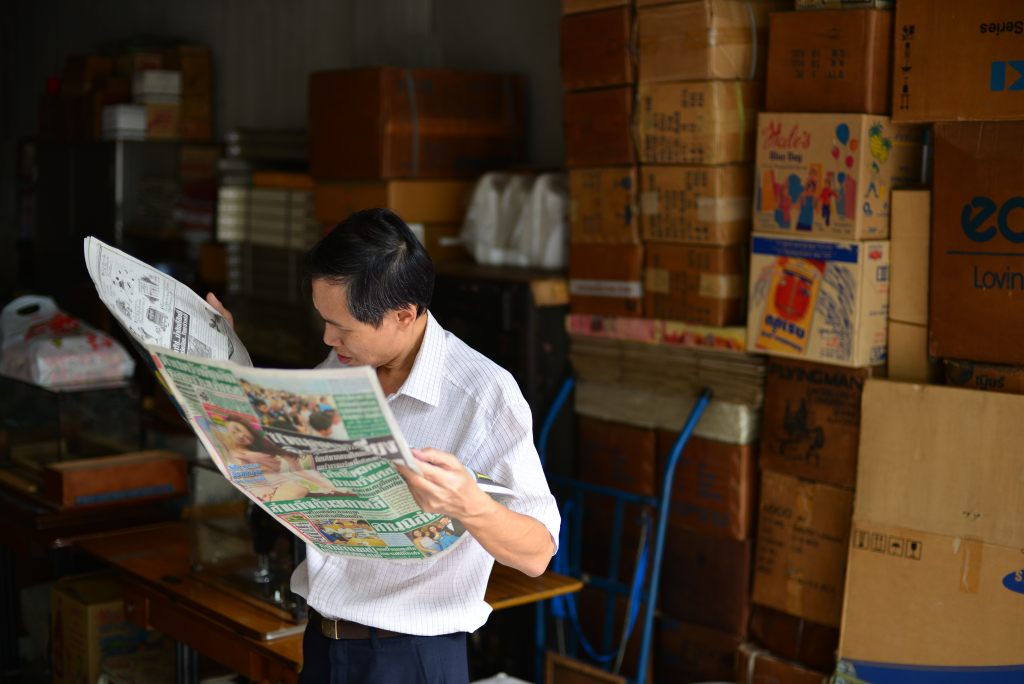
The Merrel walking shoes I bought seemed so promising when I tried them out at the Mountain Equipment Coop in Vancouver, but nothing would prepare me for the kilometres of walking today with the weight of my day pack on my back. My feet feel raw, my back imbalanced and slightly pained from the inevitable provocation of the sciatica issue that has plagued me for years.
As usual, my wildly unrealistic plans collide with the sad reality that there is only so much time and energy each day, never mind ability to deal with the inherent chaos and unpredictability of traveling in a place that is entirely unknown, the location of once familiar objects entirely new if not entirely conjectural, and one’s ability to communicate with locals highly debatable.

Earlier on in the day I thought I was probably too tired to be inspired enough to be writing anything even vaguely memorable, but as the day progresses I realize I am making far too many impressions to possibly be remembered at the end of what will turn out to be an exhausting day. Nevertheless, I mindlessly troll the internet, ignoring the increasingly warnings as to severe exhaustion setting in, never mind the pain I am feeling in my groin and in my feet. I really need to sleep – and hard bed or not, I don’t think it will take much to fall asleep today.
January 12th, 2015
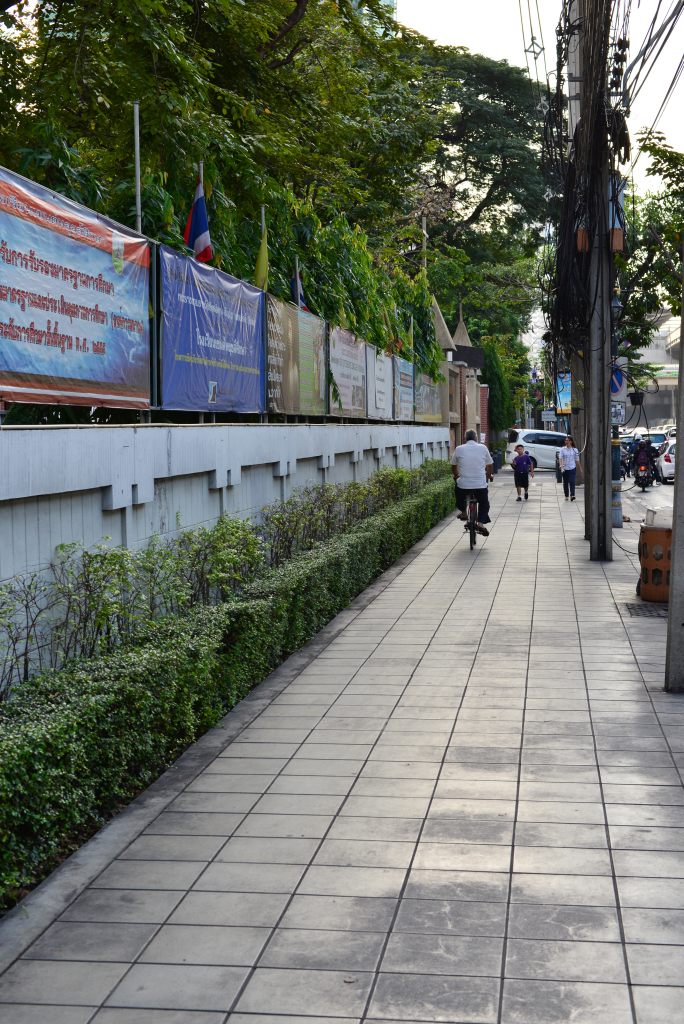
The morning is spent lazing at the hotel, largely writing and making notes. I have little idea as to what I should be taking on later on today – perhaps I could explore the area of Sathon Road running southwest of Lumphini Park, as I want to stay close to a metro line, and don’t necessarily want to trek into the old city. What’s more, the museums may be closed on a Monday. I had thought I should go to the Burmese embassy first thing this week but perhaps could postpone the trip to tomorrow. I can see getting sucked into the pressure of doing as much as possible, but that just wouldn’t go very far with me …
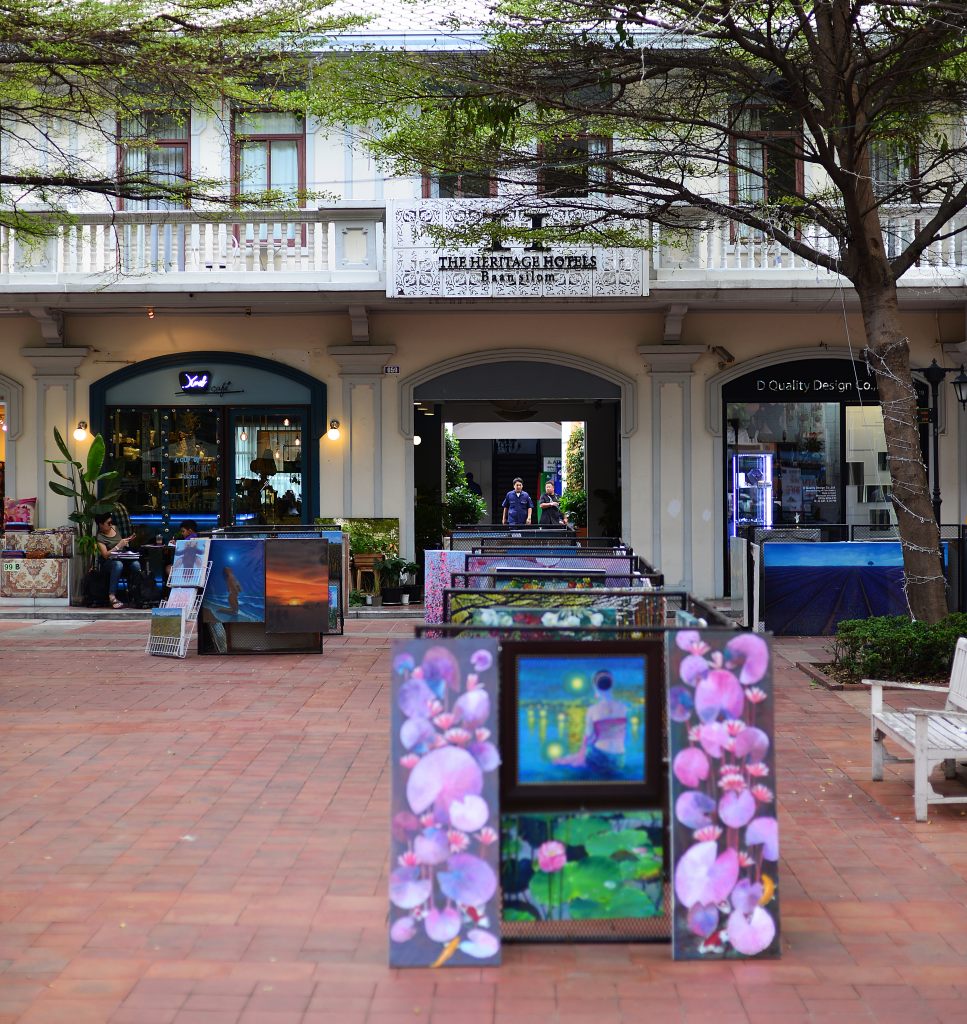
I am thankful for the Natcha cafe across the street, quiet, bright, inexpensive, with good food and excellent coffee in a clean environment, all at modest prices. The restaurant in my hotel is more expensive, the smell of grease somewhat overpowering, and the tranny waitress less than enthused. The workers at the Natcha, on the other hand, are polite, although the young man tells me he really has little time for his country, considering the incredible corruption and disregard for the common people the privileged classes have. As far as the neighborhood is concerned, he does not recommend the area around the Hwai Kwang station as the market is quite tawdry, along the lines of what I would have seen in Chinatown yesterday. And no, he can’t really recommend areas of Bangkok to hang out in, as he finds most of the city fairly regrettable, which becomes obvious as I spend the next few days wandering around the drab sprawl.
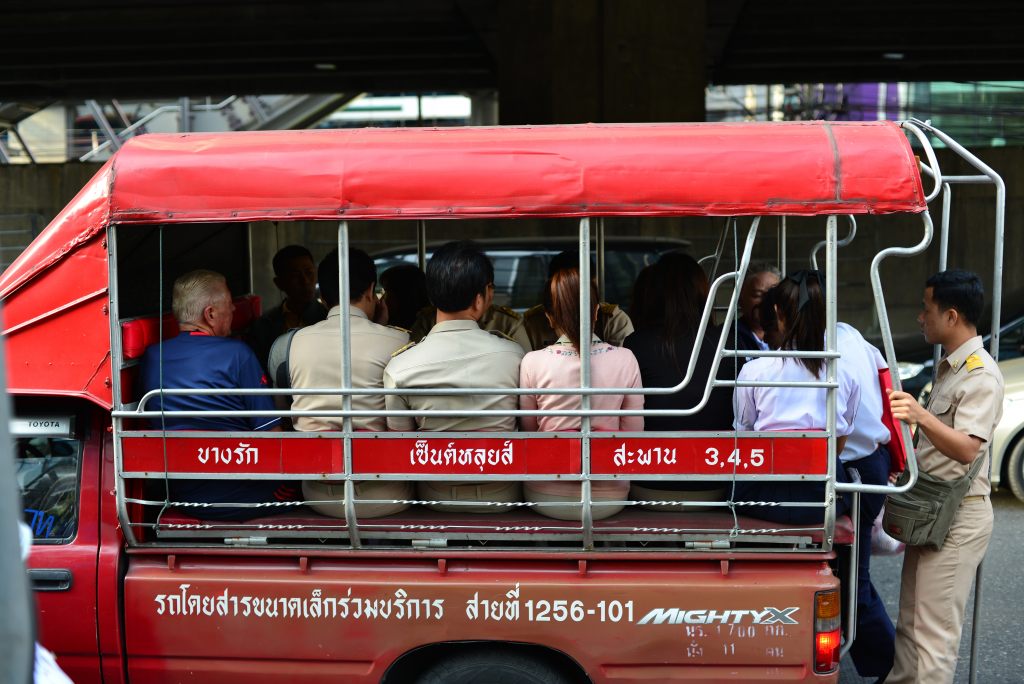
I decide to walk to the Hwai Kwang station, but there is little more to see along the main road than what you see further to the north. On the other hand, the advantage of getting onto the metro further to the end of the line is that you actually have a chance of getting a seat, which I appreciate a lot, given how much I will be walking and the effect of jet lag not having worn off yet. En route to Rachadapisek, in search of the perennial rehydration that dominates my life in tropics, I take in two baggies of cut pineapple from the street vendor. He slides the chunk of fruit into the plastic baggie and gives a few knocks with a small machete to the fruit, breaking it into smaller chunks before handing me the baggie with a long toothpick. On the other end, Lumphini station is hardly some romantic enclave, with a broad curling freeway suspended above and angular corporate towers bristling along the boulevards emanating from the park. But it adjoins one of the few green spaces in the vast sea of concrete called Bangkok.
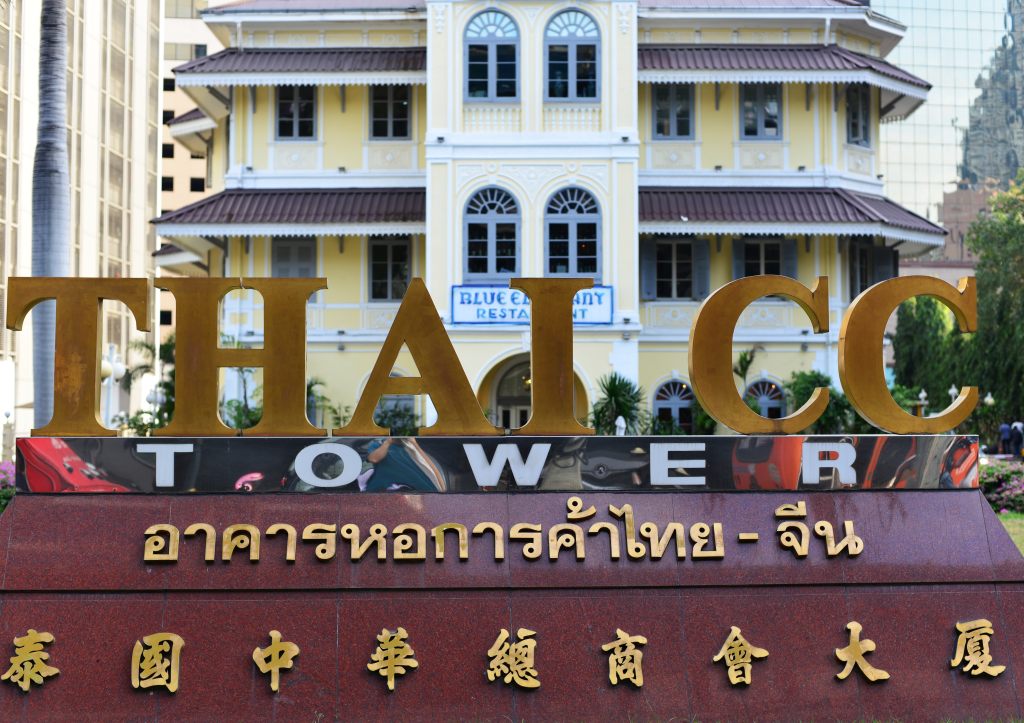
I descend down Sathon road with the intention of heading back on a parallel street. Sathon Road runs southeast of Lumphini park and is definitely no romantic enclave – just soaring corporate towers, banks, luxury hotels, with loads of money in evidence, or at least the pretense thereof. Nonetheless some of the gigantic structures are relatively innovative in their design, often encircled with striking gardens and fountains, some featuring massive atriums with cafés, restaurants and bars catering to the affluent in mutely grandiose opulence.
It definitely holds true in this country that spacious, clean and well-lit restaurants catering to foreigners and wealthy locals will be charging two to three times the rate that simple establishments would for the same food, similar to what occurs in Malaysia. There is little semblance of any kind of real Thailand here, with no street life, although there are very occasionally modest street food vendors selling grilled fish and tofu balls, wieners, chicken and fish. Ample coffee shops are evidence, redolent in expensive shopping mall glamour. The locals obviously love their coffee, or perhaps the focus is on tourists, although the usual hordes are not quite in evidence on Sathorn road, but then why would they be.
Interestingly enough, there are bike rental stations every block or so, and more of the dedicated bicycle lanes, although motorcyclists use them, which renders the lanes fairly useless.
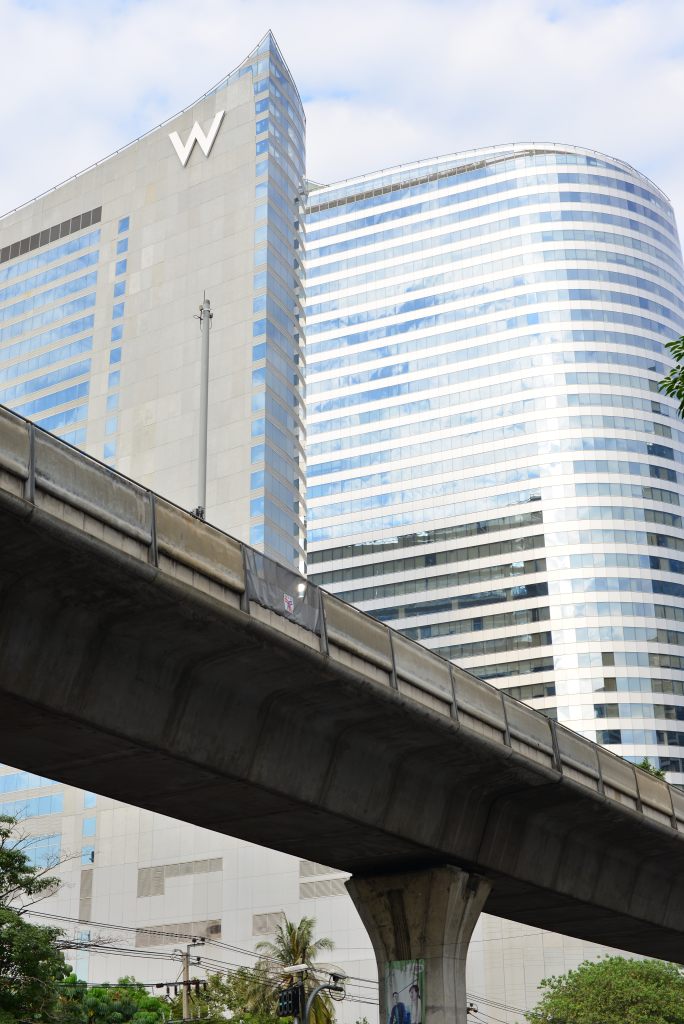
Again the day is hazy. I am not sure to what extent my photographic skills will come to any kind of meaningful fruition in this dull grey light and sea of phallic ostentation in the form of concrete soaring into the sky. The photos of the area look singularly uninspiring, although when I zoom in the detail the camera offers is incredible. I find the light is very matt on the images, even more so than what I am seeing around me. Temples with depictions of the Thai royal couple always seem to achieve particular veneration from locals passing by, irrespective of how modest the facilities may be or incongruous their position. Traffic during rush hour is far from benign, much more aggressive than what I had observed before. Even worse, I encounter bizarre traffic situations making it is impossible to cross some of the major arteries within the radius of several blocks, and that in the city centre. So much for urban design.
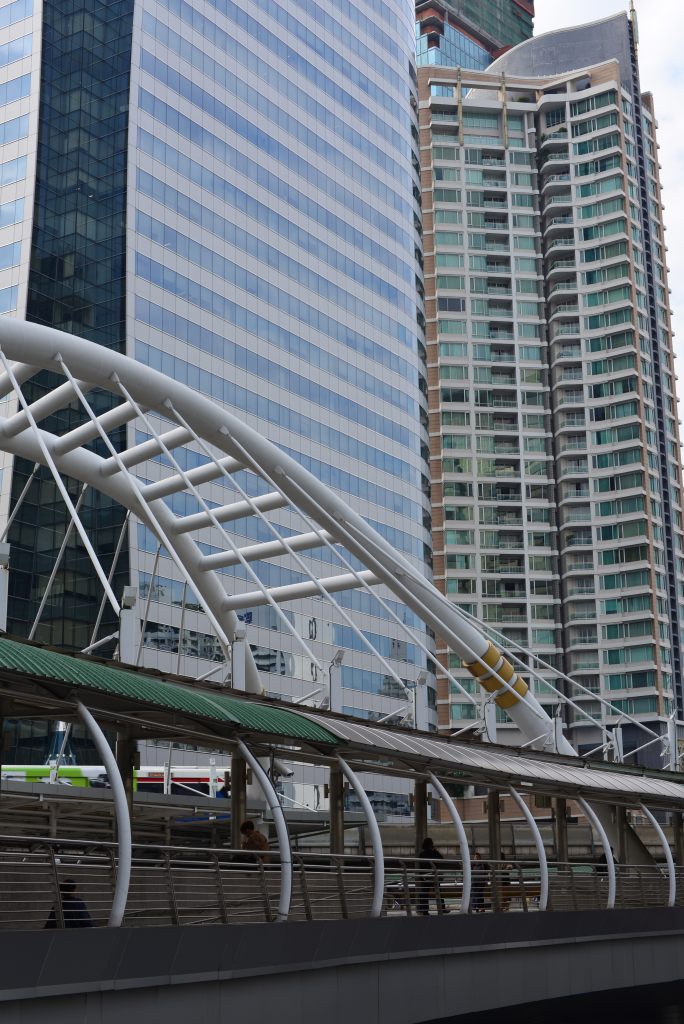
After walking through the areas southeast of Lumphini park running toward the river, I am convinced that the area I am staying in is hardly that bad. Silom Road seems somewhat less clinical and corporate, featuring an Indian area far more concentrated in terms of buildings and establishments. I pass the Sri Mariaman temple, which I don’t bother entering, seeing as how I would have to take my shoes off. In any case, I have seen enough Tamil temples in my lifetime! The number of tourists on Silom road is staggering, more representative of the degree of tourism in Thailand than what I saw on Sathorn road. Much as local people don’t gush with enthusiasm upon encountering tourists, they really are fairly approachable and try to be of assistance when asked. What surprises me is how poor peoples’ English is on the streets of Bangkok, not that I expect the citizens of a non-English-speaking country should in any way be dedicated to achieving English literacy. But Thailand is a somewhat different case, what with the overwhelming amount of tourism it experiences.
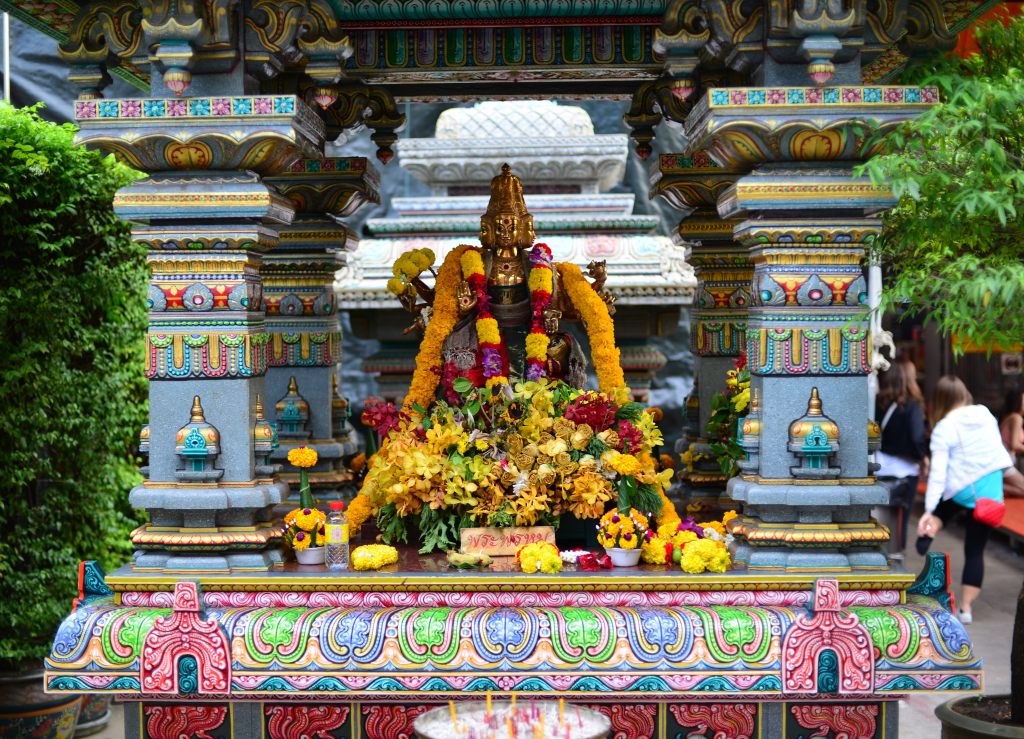
I meet two young Pakistanis on Silom road, one living in England and the other in Lahore. The two are very sweet and congenial, intelligent and critical in their thinking. They tell me that they started their trip in Sri Lanka and hated the country, as everyone seemed corrupt and continuously demanding bribes. Thailand didn’t fare much better in their eyes – they found the places they visited here such as Patpong and Pattaya fairly hideous, although also conceding that Thailand probably has far more to offer than the aforementioned places.
The sex shows on Patpong road should have been lurid but the sexual prowess displayed came across as nothing more than ambivalent and sullen. They loved Malaysia, on the other hand, the people very sweet, honorable and respectful. We concur that the world’s accessibility renders the experience of visiting facile and meaningless – you have to work a place to really experience it. I would in fact love to visit Pakistan but am frankly just fearful of the experience badly derailing. As enjoyable and lively as our conversation is, darkness is setting in, and I would prefer not to spend the rest of the evening on Silom road.
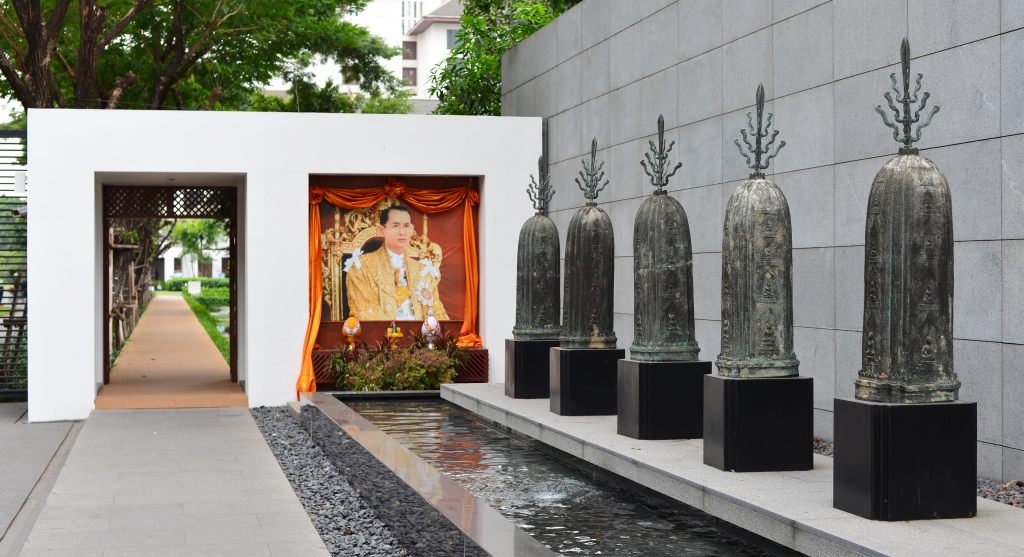
Despite the change from Sathorn road, there are hardly any attractions on Silom road, other than gaudy tourist services. The crush becomes unbearable later on as we approach Rama IV road running along the southern side of Lumphini park. I continue westward on Rama IV road, then down Surawong road, somewhat of an upscale version of Khaosan road, worth walking through once, and that’s about it. The area has a Japanese bent to it, in fact, there are many Japanese restaurants wherever there are eating establishments, to some degree a reflection of Thais predilection for Japanese food, or on the other hand a reflection of the amount of Japanese tourists here. Reflecting back on the provenance of flights at Bangkok airport, I noticed Narita was the most common originating airport. Massage parlours and overpriced Thai restaurants with bored and insincere staff abound.
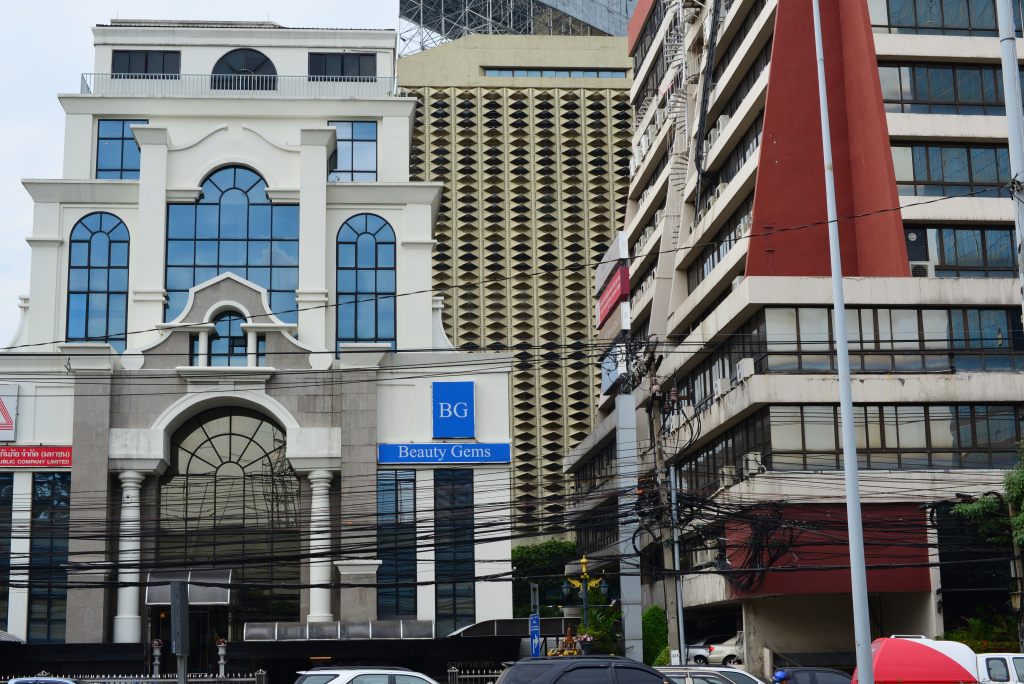
I suppose that Surawong road would be an area in which there could be cheap accommodation but I would utterly hate to be staying in this area. Further west on Surawong the clichés of Thai cuisine and easy sex dissipate into darkness, and then over to Sri Phraya road, where there are perhaps a few hotels, but the street mostly dedicated to very modest businesses, tiny bedraggled eateries, a copycat version of what you basically find on the street, numerous barbershops, the hairdressers working their profession with suitable flourish, and approaching the proximity of any sacred establishment vendors selling all manner of religious accoutrements and devotional offerings.
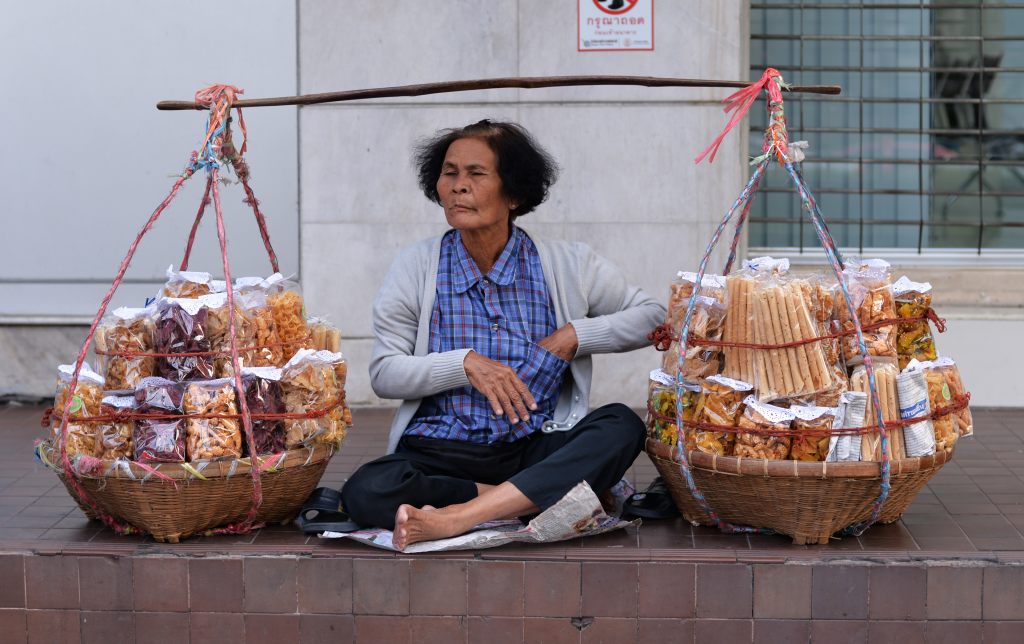
I will eventually have to think about eating somewhere as I am getting hungry, although somehow the plethora of restaurants in the area does little to entice me. The idea of visiting a Chinese restaurant here makes me shudder, considering that they are universally promoted with mounds of shark fins. On the other hand, the only Thai restaurants visible in the area cater exclusively to tourists. The roads running parallel to Sathon road describe a very different world, Sathon being very corporate while the adjoining ones much more modest, if not outright sleazy. The manner in which tourism is catered to runs the gamut from attempts at class to the plethora of massage parlours, replete with lady boys and general demographics that bespeak a roster of despair in various stages of decline.
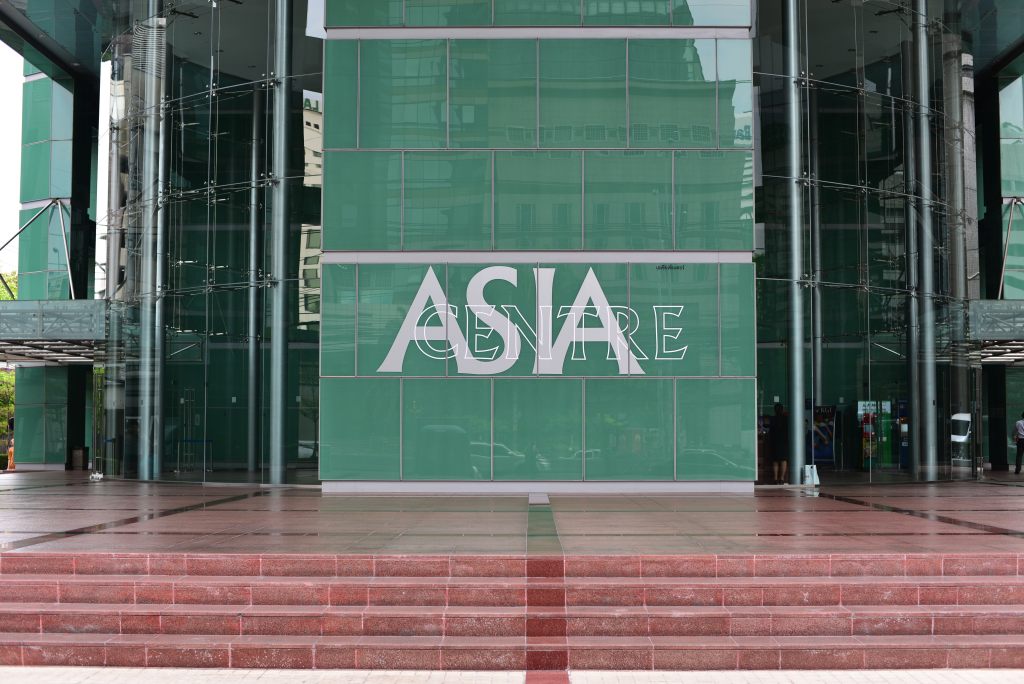
Wat Hua Lamphong is located at the junction with Rama IV road, the temple structures soaring in the darkness adjoined by somewhat of a carnival setting, with vendors of the usual street food out front with their grills and nomadic sensibilities, what seems to be a petting zoo with a group of cattle, rows of what look like lottery ticket vendors and assorted other structures. It seems as if crossing Rama IV road will present yet another debacle, given the fact that the road here is feeding into overhead freeways. I continue walking eastward but find no possible venue for crossing. In the lobby of a glamorous hotel with a vast interior restaurant I am advised by the elderly matron at the reception that I need to return to the Hua Lamphung metro station, from which an underground passage will take me to the mall.
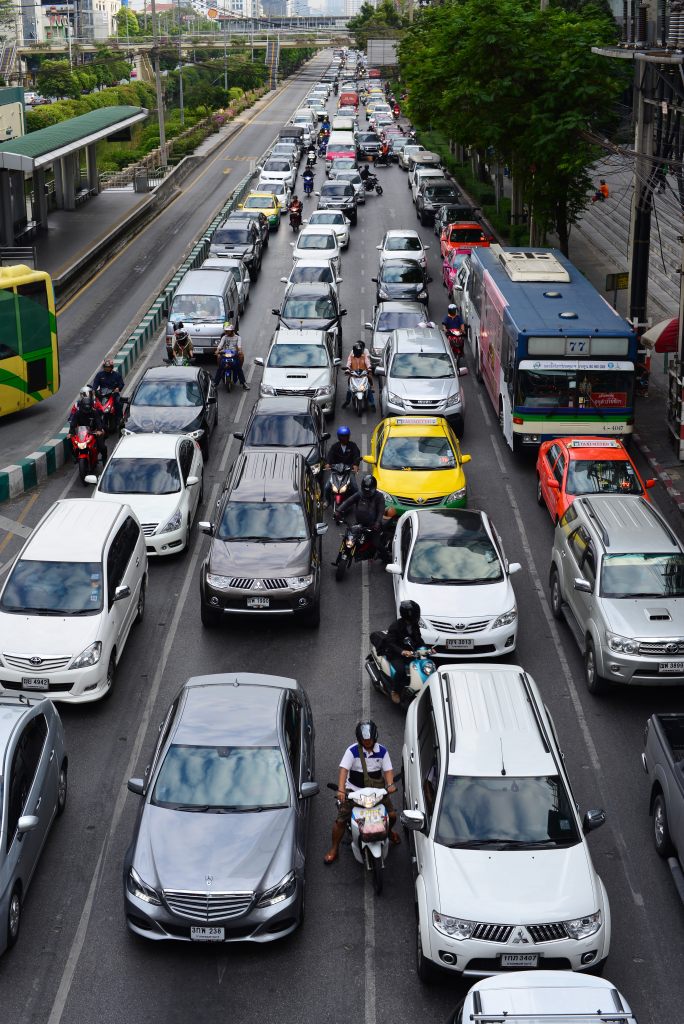
Chamchuri Square represents another extravagant gesture of crass mall-based commercialism characteristic of the city that becomes repetitive after a while, although wading through cramped markets in the sweltering heat could represent a far worse option. A very sweet young woman in the glass elevator overlooking the vast atrium dropping below us assures me that there are opportunities to take in food on all levels in the mall, although upon cruising through level upon level it all just becomes more of the same rice and noodles stewed together with some meats and sauces in generic east Asian fashion accompanied by loads of sugary drinks, characterized by little in the line of cultural specificity or culinary distinction.
I find one stall that features an authentic selection of Thai food, much of its offering salads combining fruit, meats, greens, diced and tossed together with lime juice, very flavourful, the apparently lower prices offset by the tiny portions. Oh well, this is a big city and you take what you can get – I just don’t want to eat on the street, although the grilled meats always seem to represent a safe option, at least in terms of predictability. The Tesco in the basement of the mall is too small to be interesting, although happily you don’t have to leave your bags at a bag check, which I have not seen here yet, and which I would not be too comfortable with, given the costly camera equipment I am hauling around.
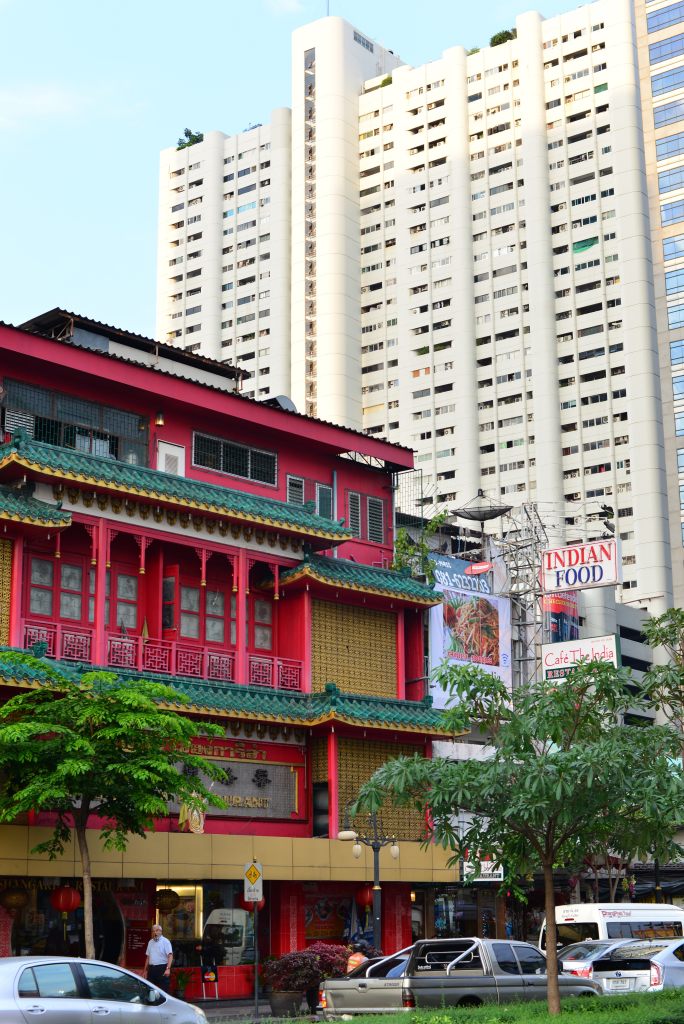
I am happy to get onto the metro, and at the second station there are still seats, the trains eventually flooding with passengers even this late in the evening. I see construction workers returning from work, none of the glamorous, clean-cut iPhone-bearing young Thais you see otherwise on the Skytrain. I wonder who fuels all the cheap labour here – does Thailand have such an ample supply of cheap labour, or are these mostly illegals from the neighboring poorer countries? The construction boom in Malaysia is largely fueled by cheap Indonesian labour …
I had intended on coming back to the hotel and getting lots of writing done but that notion quickly falls apart as I sink onto the mattress in exhaustion. Then the usual schizophrenic experience arises with the air conditioning, the room being either too cold when the air conditioning is on, then too hot when it is off.
January 13th, 2015
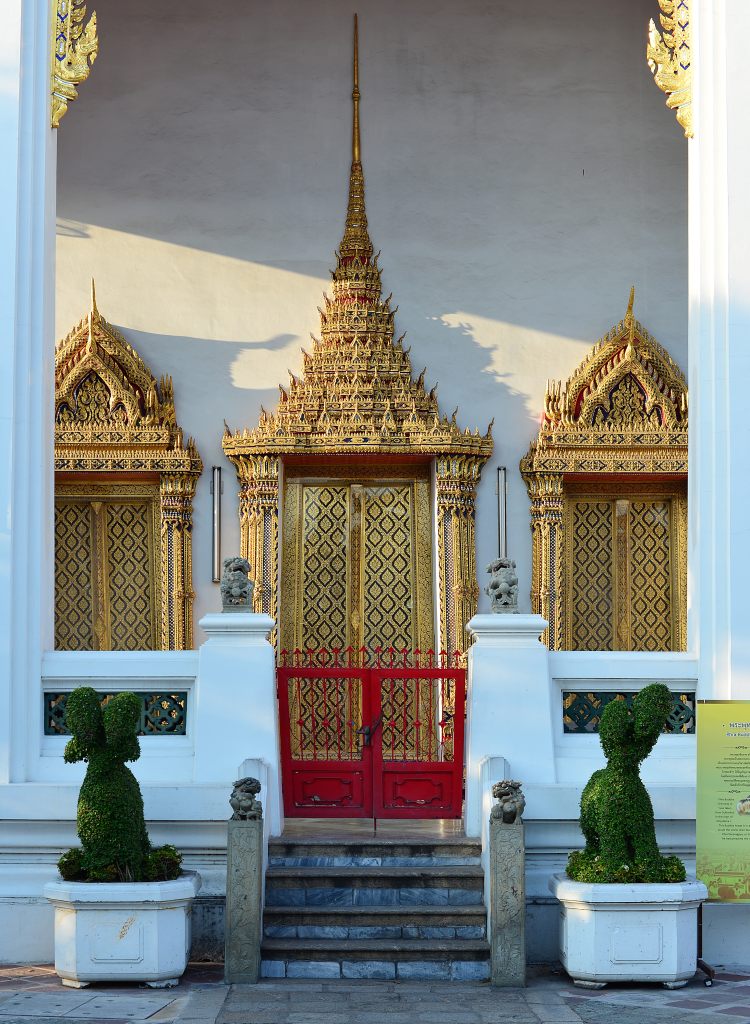
I finally made it to the rooftop terrace of the hotel to take in the alleged swimming pool. Almost shockingly, the long rectangular pool occupies the bulk of the rooftop, looking out over the entire neighborhood, the brilliant blues in stark contrast to the cream towers clustered along Ratchadaphisek Road and the sea of green below. The young Finns lounging around the pool seem to be enjoying their amount of bliss in the city, also somewhere in disbelief that a hotel this cheap can be so exclusive in its feeling. They find my passing remarks about the dominantly Russian tourism on the ground amusing.
But as alluring as this mid-city beachfront setting with view may be, I am on a mission, and have to head into town. The need to rehydrate before even setting foot in the metro runs aground with the first vendor in front of the hotel, commanding a steep 50 baht for a baggie of jackfruit – either he is deliberately overcharging or fruit is as expensive here as in Malaysia. No matter, there is competition further down the road …
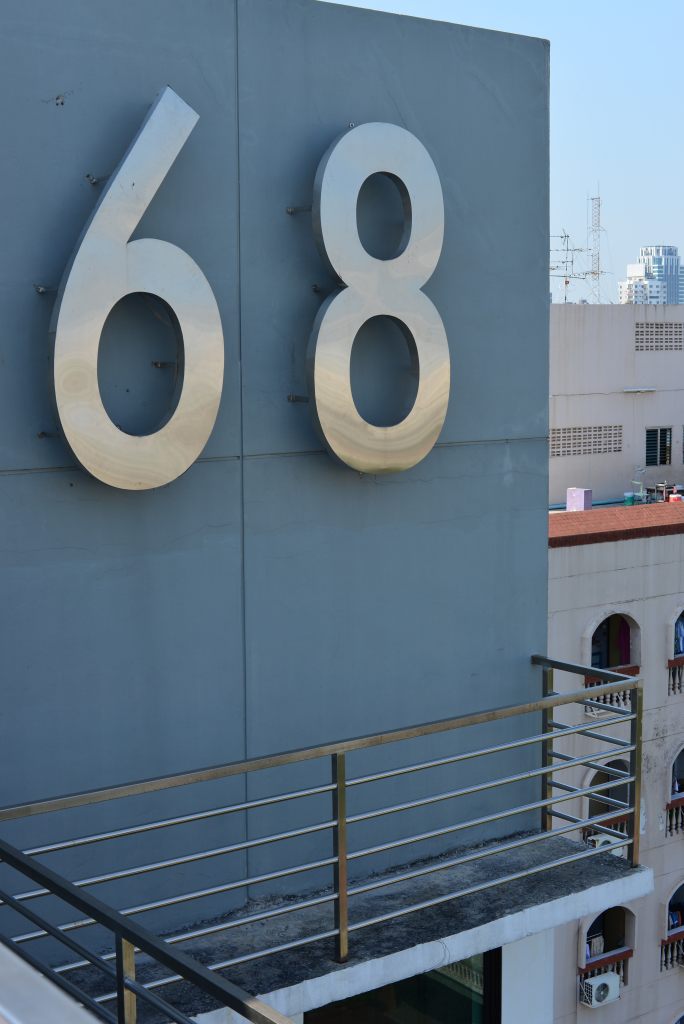
The ticket vendor in the metro station takes serious umbrage at my comments as to her good looks, her colleague seated at some distance looking over at us bashfully, not that my intentions weren’t entirely innocent and an observation of fact. Oh well … they are probably very sick of the hordes of predatory tourists, although the vast numbers of foreigners commuting on these trains appear to be on their best behavior. Sitting in the thankfully very well air conditioned metro on the long trip into town offers a good opportunity to catch up on my journal entries, before my body and mind dissolve into an agonized turgid boiling mess. The older man seated next to me on the metro is a classic, flamboyantly tying his tie in the reflection of the opposing window, continuing to comb his hair and righten his shirt, all with as much flourish as possible, and to the indifferent if not skeptical looks of surrounding passengers. The somewhat elusive penchant of Thais for the eccentric …
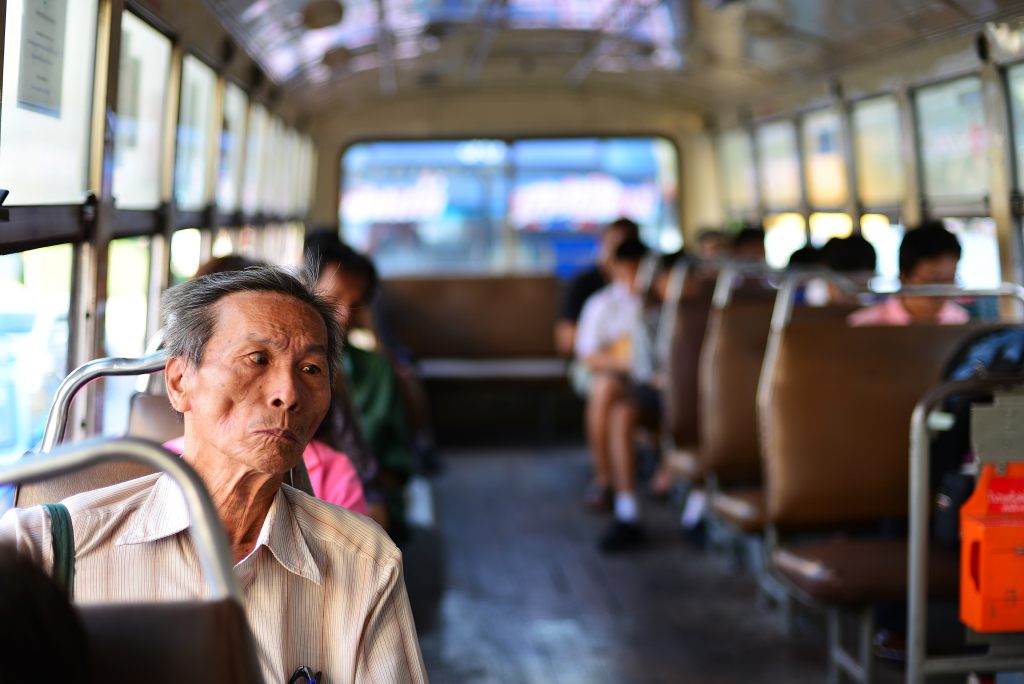
I had the intention of traveling directly to the Royal Palace today, but again come across the obstacle of lack of rapid transit access to the old city. At the Hua Lamphong train station, tuktuk and cab drivers shout at me boisterously, but my mind is made up – I am taking the bus. Because of lack of organization or construction around the train station, it is not at all clear as to where the buses stop. A travel agent points me to a woman standing expectantly under the crowd of a tree – that’s where the 53 bus stops and it will take you to the Royal Palace. Finally I am seated happily on the bus without having to fend off further tuktuk dirvers.
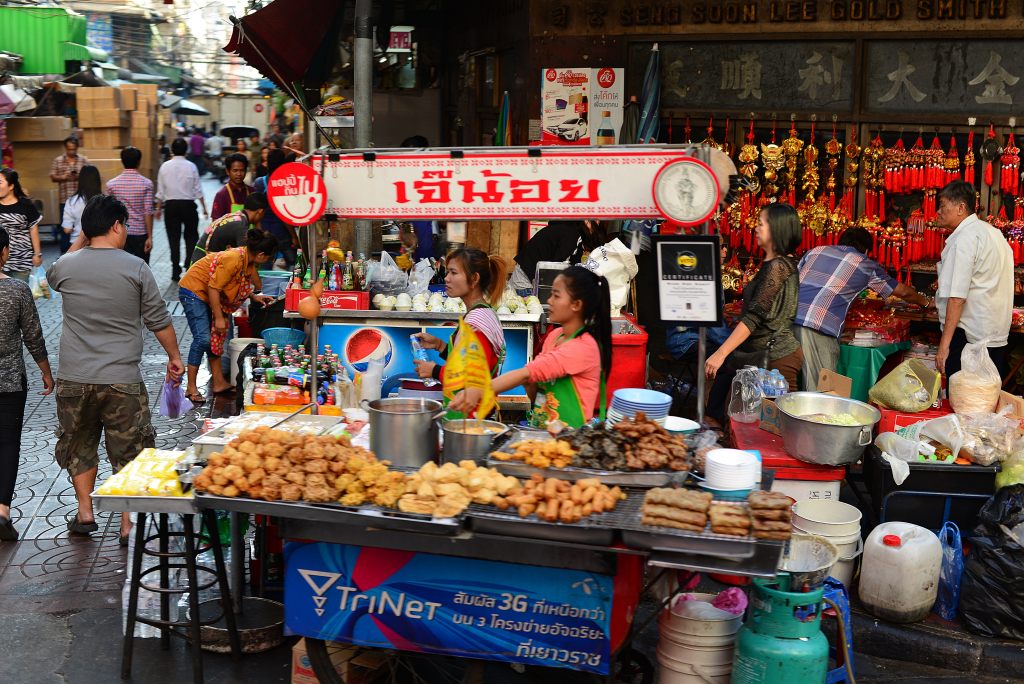
The old rickety bus lumbers along and is soon embedded in a barely moving morass of traffic. Even worse, I have no idea as to where we are. I am not expecting to recognize the road to the Royal Palace in intimate detail, given that any knowledge of inner city Bangkok would be limited to the impressions made yesterday alone, but I simply don’t recognize anything around me. Given the position of the sun, we seem to be heading west, then suddenly we are not, then we are again. And for the most part we barely move. And there it is again – the Hua Lamphong train station! Really? We spent the entire last half hour just trundling around the vicinity of the train station? I shake my head in disbelief.
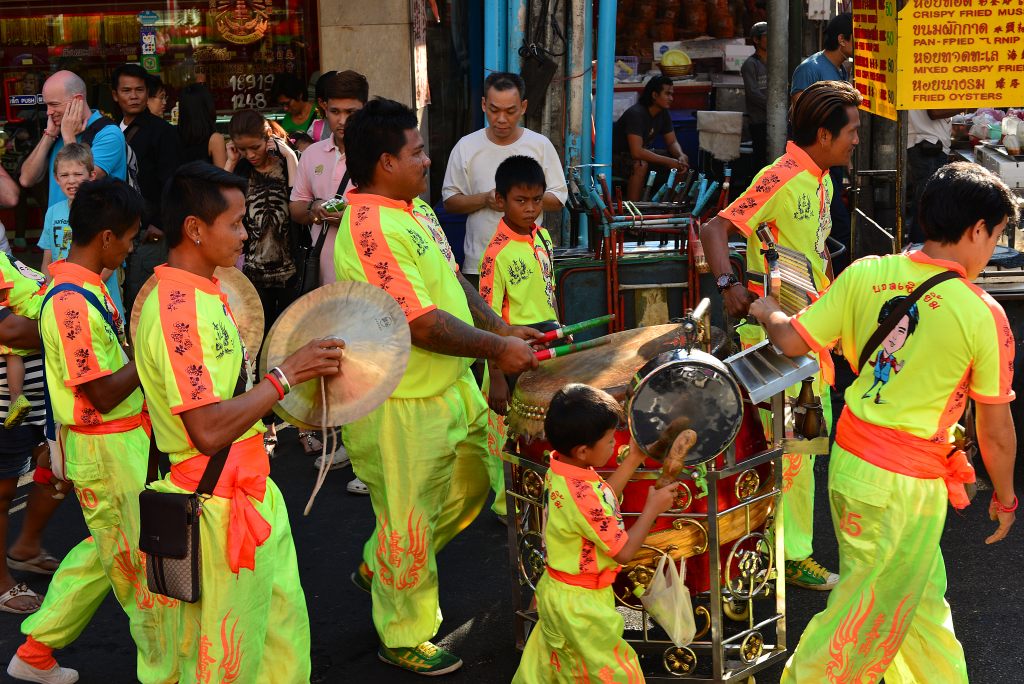
Now we descend into the mess of Chinatown, the camera suddenly clutched in my hands, crouching down and leaning out the window, attempting to capture vignettes of the incredibly compressed street life, the array of store fronts fronted by a thicket of ambulatory vendors. While many have already packed up for the day, the traffic is incredibly slow-moving, the bus stops frequent, and the lengthy route utterly circuitous.
The photos should in theory be excellent, and certainly the detailing is there – but now I am struggling with lighting, the same issue as I had with my old Nikon, where any shots vaguely in the direction of the sun are either too dark or too bright. Another big change for me is the fixed length prime length prime lens (50 mm), limiting my ability to compress and juxtapose images as I did with my zoom lenses.
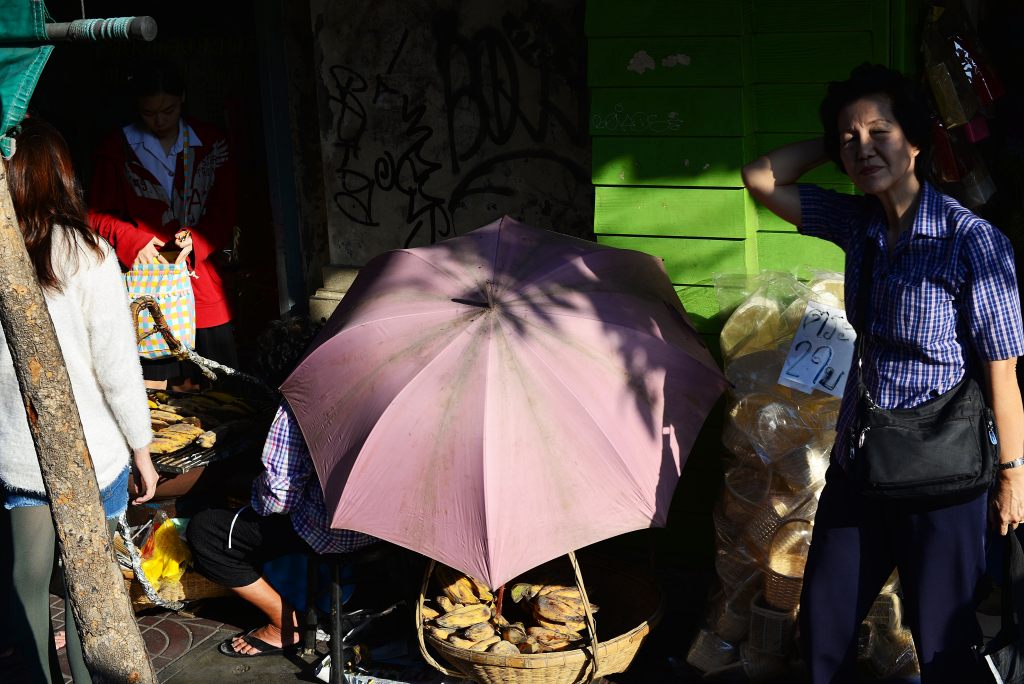
I hurriedly disembark, thankful to be rid of this mobile headache. Hugging the walls running closest to the river, I pass the cream walls of the royal Palace, the tuktuk drivers not too aggressive, the sun shining, and the food stalls lining the road proper, in fact even inviting. Street vendors gather their modest goods onto their small wagons, at times loading vehicles, the less enfranchised settling down to an evening on the street ensconced in a few sheets, their deeply bronzed countenances seemingly divested of the concerns of the world around them. Lying below the royal palace, one of the most important attractions in the city is Wat Pho, its appeal to some extent a spaciousness that never seems to be limited by the numbers of tourist that overrun the temple complex.
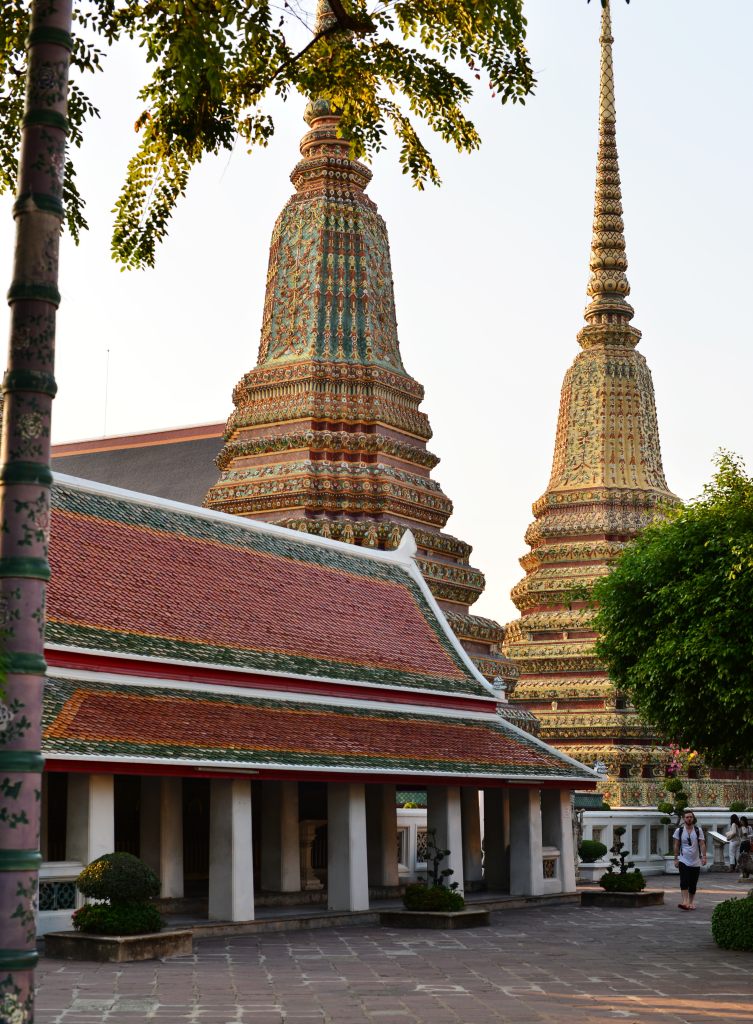
Wat Pho was built over a temple from the Ayuthaya period, and is today one of the most important royal temples in Thailand, predating the founding of Bangkok, and featuring four large chedis or stupas, almost 100 smaller chedis, a central shrine, and several viharas. Wat Pho holds the largest collection of Buddha images in Thailand, one thousand in total, including a 46 m long reclining Buddha.
It is the birthplace of traditional Thai massage, a center for traditional Thai medicine, and also Thailand’s first university. Its structures are elaborate, oozing in gilt decorative features, with lavishly embellished pavilions, internal walls frescoed with stylized depictions of court life. Rows of golden Buddhas line the corridors, hypnotically vanishing into their respective horizons.
Radiant golden spires are set against the viharas’ terracotta roofs and peaked canopies, staggered gables culminating in the slender golden finials erupting from peaked edges characteristic of Buddhist architecture.

The roadside abutting the Ko Ratanakosin riverfront is vaguely bucolic in nature, its possibilities limited by the jumble of functional buildings feeding into the palace complex and general urban blight. The appearance of exclusivity of the Tha Maharaj pier near the royal palace is based on a desire to build an identity that rises at least somewhat above the city’s obnoxious shopping mall ethos, its economic viability assured even if the most miniscule sliver of tourists deluging the royal palace considers turning its attention this way.
I gain access to the river boat docks, the Chao Praya river representing a very convenient and efficient way of traversing the city core north to south, although it also holds a lot of sway with tourists for panoramic views of the city, few of Bangkok’s numerous attractions far from the river, although the city is just huge anyway. Then the traffic in the centre is truly nerve-wracking.
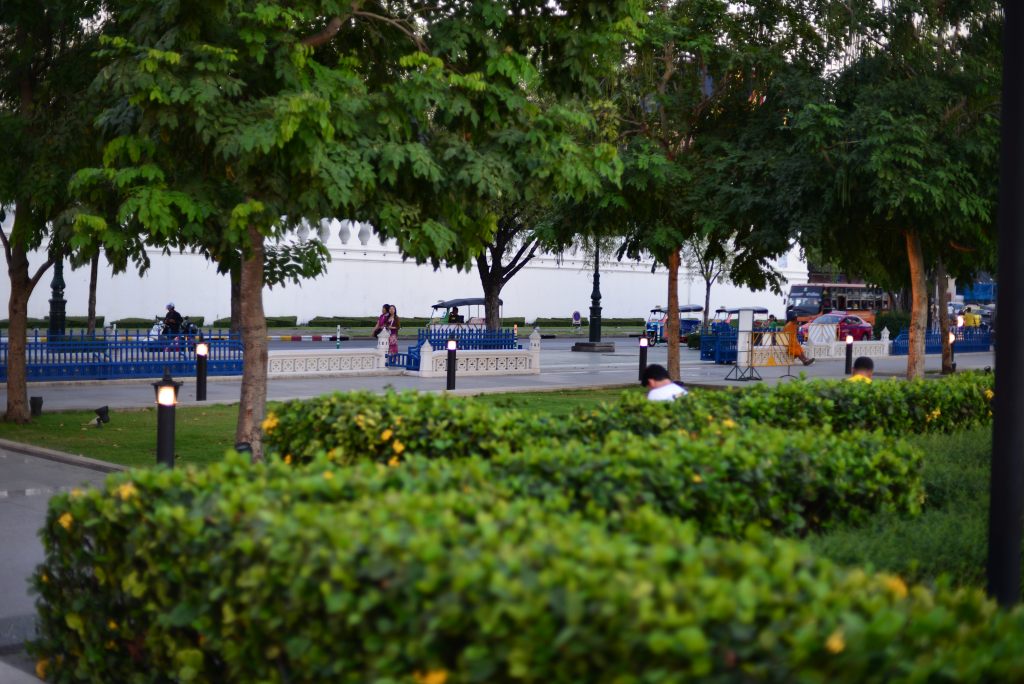
With not much more to see in the fading daytime hours and a long and potentially confusing return to north Bangkok lying ahead of me, I contemplate another long trek back to the Hua Lamphong metro station, although at least I feel I am getting back into the swing of things. Whatever little incentive there could be to while away the time in the old city is offset by the potentially arduous return to the far reaches of Rachadapisek. Taking on the exploration of Bangkok on foot is no mean feat – and there is a lot of competition given the vast number of tourists I see on the ground here.
And yet east of the centre there are few Caucasians to be seen, certainly in the approaching evening. I had decided to walk all the way back to the Hua Lamphong train station to the east, the idea being based on the somewhat delusional notion that my print map represents the distance with any degree of accuracy. So much for not having a cell phone with mapping capabilities. Nevertheless, I made good headway, even though the trip is long. Rounding the end of the long grassy field jutting out from the Royal Palace, the passing buses look tempting, but I just do not want to repeat the frustrated experience I had earlier on.

